

How to Write a Case Study: A Complete Guide with Templates

Writing compelling and insightful case studies is a marketer’s biggest job, yet most get frustrated with this content. The challenge? Figuring out how to write a case study that not only highlights the company’s strongest suit but engages new clients with strategic information. If you often struggle with making case studies as more than just dry facts and figures, you’re leading your efforts to missed opportunities.
How to Write a Case Study Step-by-Step
- Craft a Compelling Headline: Highlight the main success with a clear, direct title.
- Start with a Strong Introduction: Provide a broad overview and hook the reader.
- Discuss Unique Client Challenges: Highlight specific industry-related challenges.
- Highlight the Solution: Showcase your strategies and key results.
- Present Quantifiable Results: Use data and visuals to demonstrate impact.
- Be Clear and Concise: Stick to the point and support claims with data.
- Treat Your Case Study Like a Story: Focus on the customer’s journey and success.
- Use Direct Quotes from the Client: Add authenticity with client testimonials.
- Make the Key Takeaway Clear: Reinforce your expertise and the solution’s value.
- Include a Call to Action (CTA): Guide the reader on what to do next.
- Make It Readable: Use simple language, short paragraphs, and bullet points.
- Finalize and Proofread: Review for errors and ensure a smooth flow.
In this blog, you’ll discover a step-by-step guide that simplifies the process, making it easier to create interesting case studies. From planning to writing, I’ve got you covered. So, let’s start with some basics.
Table of Contents
What is the format of a case study.
- How to Plan a Case Study
How to Write a Case Study
How to summarize a case study, how to cite a case study.
A well-structured case study isn’t just a collection of facts—it’s a powerful marketing tool that tells a compelling story. Using the right format for a case study ensures that your message is clear, engaging, and impactful.
The proper format guides readers through the narrative with hierarchy and scannability, helping them connect with your brand on a deeper level. Most importantly, it empowers you as a marketer to set clear goals for presenting your case studies and ensures you deliver the correct information effectively!
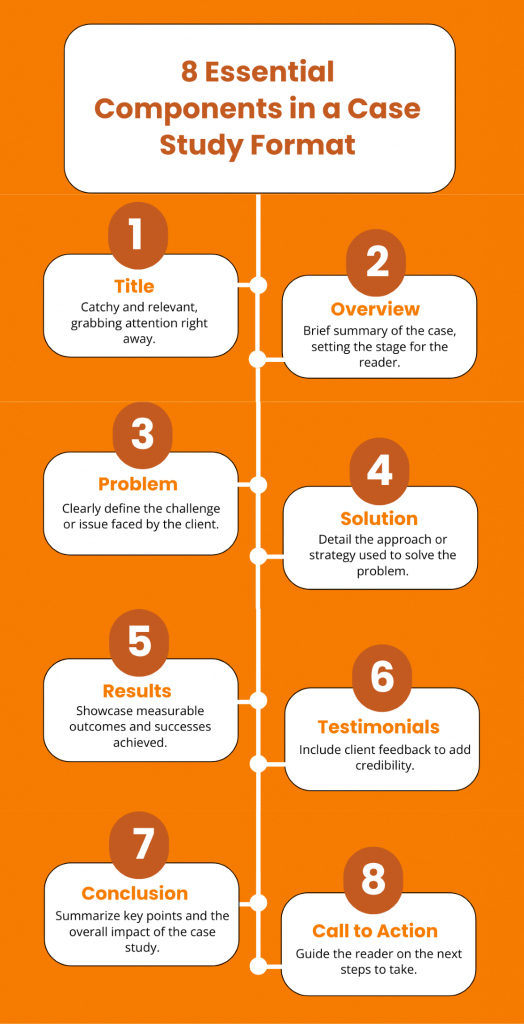
Case studies format helps you to plan and write the case study for your clients. With this outline in mind, you can create steps to complete the process of writing and publishing your case study research. There are eight components of a case study that are essential for building a layout of information in the correct order that makes sense to the viewers.
Start with a catchy “Title” that grabs attention and an “Overview” that sets the stage. Clearly define the “Problem” your client faced, and then showcase your “Solution” in detail. Highlight the success with “Results” that are measurable and impactful. Add authenticity with “Testimonials and Quotes” from satisfied clients. Wrap it up with a firm “Conclusion” and a compelling “Call to Action” in the “About Us” section that guides the reader on what to do next.
By following this format, you create a case study design that resonates with your audience and effectively showcases your brand’s value.
Check out the marketing case study template I’ve included below—it has a clear outline that makes it easy to see how sticking to a format can help you plan and write the entire thing.

How to Plan a Case Study
Now comes the big part! Understanding what to include in a case study outline is just the starting point for beginners. The real challenge lies in creating a step-by-step plan to craft that outline and filling it in with the right information!

1. Set Clear Goals for Your Case Study
Before diving into how to write a case study, defining your ultimate objective is essential. Think about it—what do you want your audience to take away from this case study? For example, your goal is to showcase how your SEO strategies boosted a client’s organic traffic by 150% in just six months. This clear goal will shape your entire narrative and ensure that your case study is laser-focused on demonstrating your expertise and the value you bring.
2. Select a Client that Highlights Your Strongest Suit
Choosing the right client or subject is vital while creating case studies. Imagine you’ve worked with a small e-commerce brand struggling to rank for competitive keywords. Your strategies helped them rank on the first page and increase conversions. This is the perfect client for your case study because their success story directly showcases your SEO prowess.
By picking a client whose experience aligns with your goals, you’ll create a case study that resonates with your target audience.
3. Reach Out to Your Client for Collaboration
Now that you’ve identified the ideal client, it’s time to reach out. Let’s say you contact your client and explain how a case study can highlight their remarkable success story. It’s a great way to spotlight a mutual collaboration based on credibility. Their buy-in is crucial; their insights and data will authenticate your case study.
4. Gather Comprehensive Data and Insights
Data is the lifeblood of any compelling case study. For instance, in your SEO case study, you’ll need to gather data on key metrics like keyword rankings, organic traffic, and conversion rates before and after implementing your strategies. Let’s say your client saw a 50% increase in organic traffic within three months of optimizing their website. Collecting this data will help you build a robust, evidence-based narrative highlighting your impact.
It’s essential to monitor the before-and-after data to track the effectiveness of implementing your strategies.
5. Prepare Insightful Questions and Conduct Interviews
It would be best to ask the right questions to get the most out of your client interviews. Imagine asking your client, “What specific challenges were you facing with your organic search rankings before we started working together?” or “How did our SEO strategies help you achieve your business goals?” These questions will lead to detailed responses that add depth to your case study, making it more than just numbers on a page.
Always ask questions that uncover the key challenges your clients face. This way, your prospects will know when to turn to you to navigate or overcome similar obstacles in their business.
Since I’m giving an example of an SEO case study in marketing, you can try these questions to interview your existing client. Obviously, you can modify the sentences according to your industry basics, but these types of questions are fundamental for collecting structured data from your clients.
- What were your business’s main SEO challenges before we started working together?
- Can you describe your initial expectations for implementing our SEO strategies?
- What specific SEO tactics did we implement that you found most effective?
- How did you monitor and measure the impact of these strategies on your organic traffic?
- What were the key metrics or results that stood out to you after the first three months?
6. Ask Questions That Drive the Story Forward
Impactful questions are the backbone of a strong case study. They allow you to highlight the unique value you delivered to your clients. You can effortlessly showcase your USPs within the case study by asking the right questions.
Focus on inquiring about the effectiveness of your services and strategies, their impact, and which aspects of the solution were most beneficial. This insight will be your key to demonstrating the tangible benefits you offer your clients.
Consider asking questions like:
- Can you share a moment when you first noticed a significant improvement in your website’s organic traffic?
- How did the increase in organic traffic impact other business areas, such as lead generation or sales?
- What feedback did your team or customers receive regarding the changes in your site’s performance?
- Looking back, what do you believe was the most critical factor in achieving these results?
- How has this success with SEO influenced your overall marketing strategy moving forward?
These types of questions encourage clients to share their experiences in a way that paints a vivid picture for your readers, making the case study more relatable and engaging.
7. Draft a Clear and Organized Outline
With all the data and insights gathered, it’s time to create a well-structured case study outline. Let’s say you start with a brief overview of your client’s business and its challenges, followed by a detailed account of the SEO strategies you implemented. Then, you showcase the results with hard data and close with client testimonials and a solid call to action.
As mentioned above, organizing your content in a logical, easy-to-follow format will help you write a case study that not only informs but also captivates your audience.
These steps are the cornerstones of designing a case study. Once you complete this checklist, you can proceed to the next step, which is writing a case study. Since I discussed planning an SEO case study extensively, here is a case study template that perfectly illustrates the process.

You want to create an informative case study for your prospects. But how do you make sure it’s done right? Here’s a step-by-step guide on how to write a case study that drives results.
1. Craft a Compelling Headline
Your headline is the first thing readers see, so make it count! It should grab attention and hint at the success story you’re about to share.
How to Write a Case Study Title:
1. Highlight the Result: Showcase the critical success, like “Increased Sales by 200%.”
2. Be Clear and Direct: Make sure the headline is straightforward to grasp.
3. Use Action Words: Start with strong verbs like “How We” or “Achieved.”
4. Mention Client or Industry: Include relevant details for specificity.
5. Keep It Short: Make it concise and attention-grabbing.
2. Start with a Strong Introduction
Kick off your case study with a broad overview that sets the stage. Provide the big picture and construct a clear narrative that draws readers in, making them eager to learn more about how you solved a significant challenge.
Look at the consulting case study template , which includes a stunning overview description and precise instructions for writing a short and compelling introduction. You can add every little detail to hook the reader.

Get This Template and More
3. Discuss Specific Challenges of Your Client
This is where your prospect can truly connect. By highlighting unique yet specific challenges to their industry, you give them insight into issues they might not have encountered yet—or ones they’ve already faced. This way, they’ll know exactly who to turn to when similar challenges arise.
The following financial case study template provides a brief flow of the company’s common challenges in the financial analysis process. The template is almost ready to use with this domain-specific content, requiring minimal adjustments to design your case study.
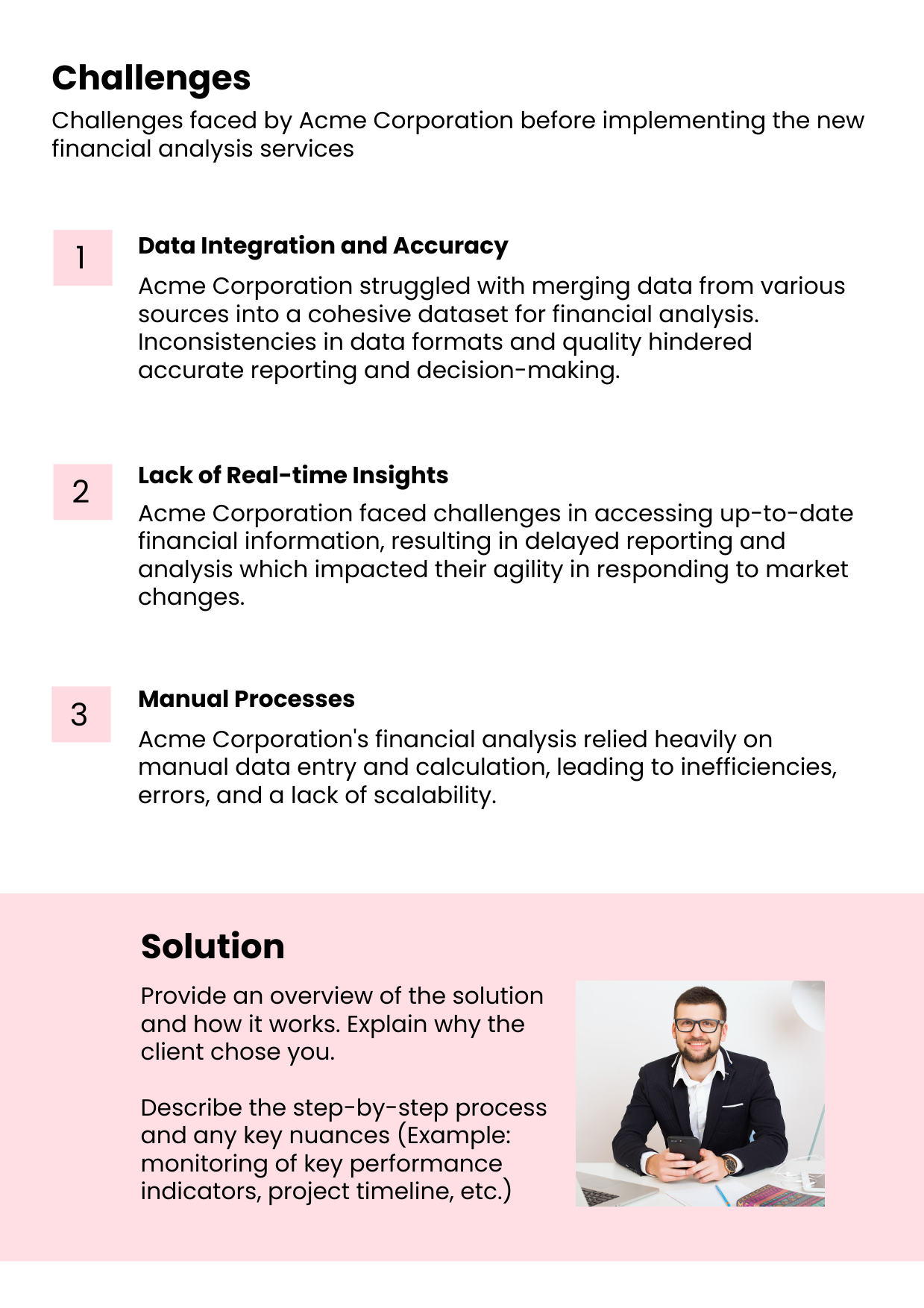
4. Highlight the Solution
Now, dive into the heart of the story. Highlight the solution you provided, and make sure to include a notable achievement or key result. This is your chance to shine!
Check out the format for presenting the implications of your service on your client’s business. The benefits should be well-written and data-driven to convince your upcoming clients. This graphic design case study format helps you understand the specific impacts a company seeks from a reputable graphic design firm.
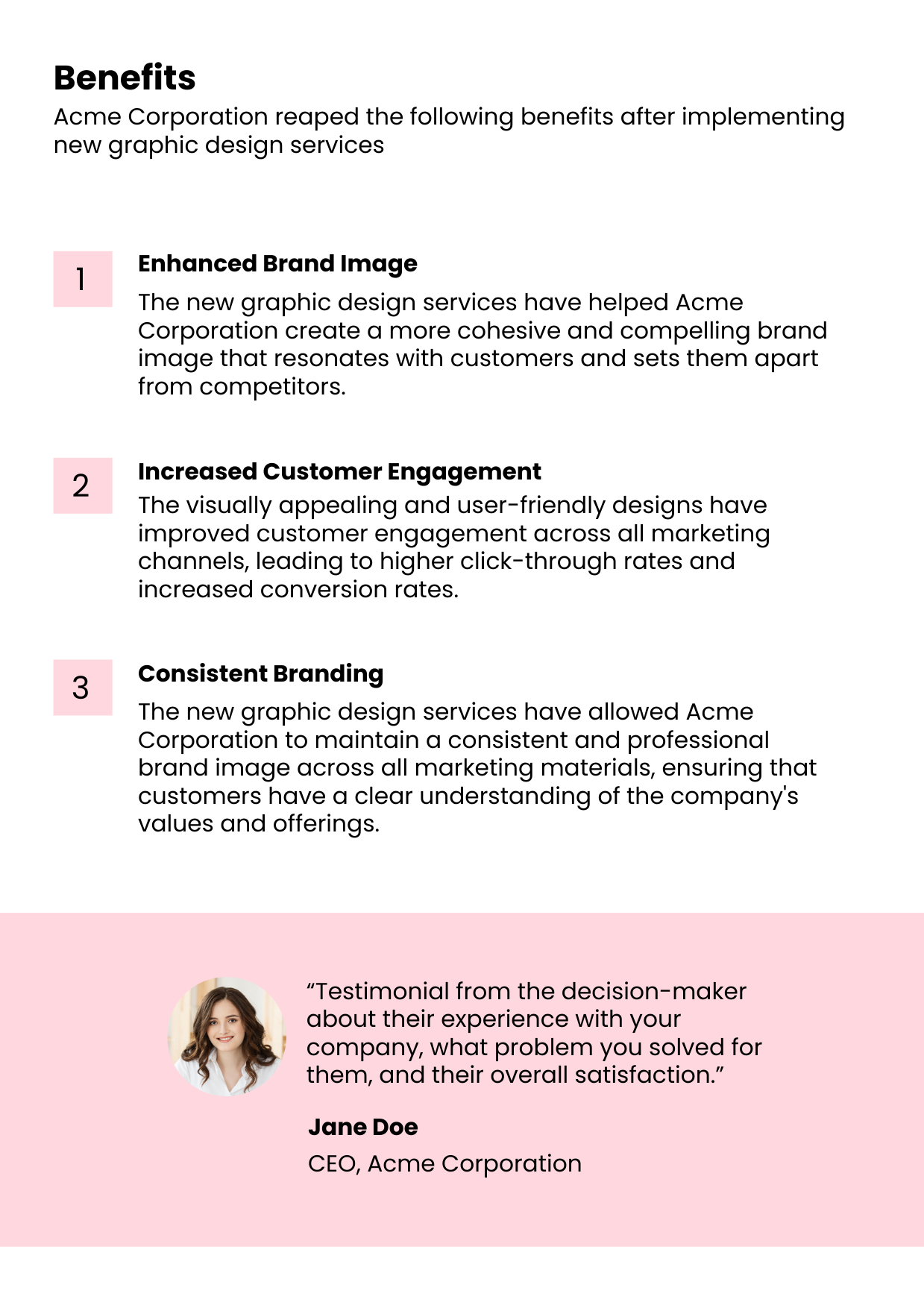
5. Present Quantifiable Results
When sharing the outcome, numbers speak louder than words. Present quantifiable results that clearly demonstrate the impact of your solution. Use graphs or charts to make the data easy to digest and visually appealing.
6. Be Clear and Concise
Less is more. Stick to the point and offer just the right amount of detail to keep your readers engaged. Include data that supports your claims, but avoid overwhelming them with too much information.
Here’s a stunning sales consulting case study that uses a simple case study layout and details written in readable, plain language to gauge more utility.

7. Treat Your Case Study Like a Story
Focus on your customer’s journey. Think of your case study as a story in which your client is the hero, and your solution is the tool that helped them succeed. This approach will make your case study relatable and compelling.
8. Be as Specific as Possible
Don’t be vague—details matter. Mention the specific company and its industry to let your audience know that the challenge and solution are relevant to them. The more precise you are, the more credible and trustworthy your case study will be.
Check out the sample case study below for payroll accounting. The details are clearly organized and grouped to emphasize the type of case study.

Also, the next case study template displays very specific problems that a company faces when it lacks digital marketing expertise.
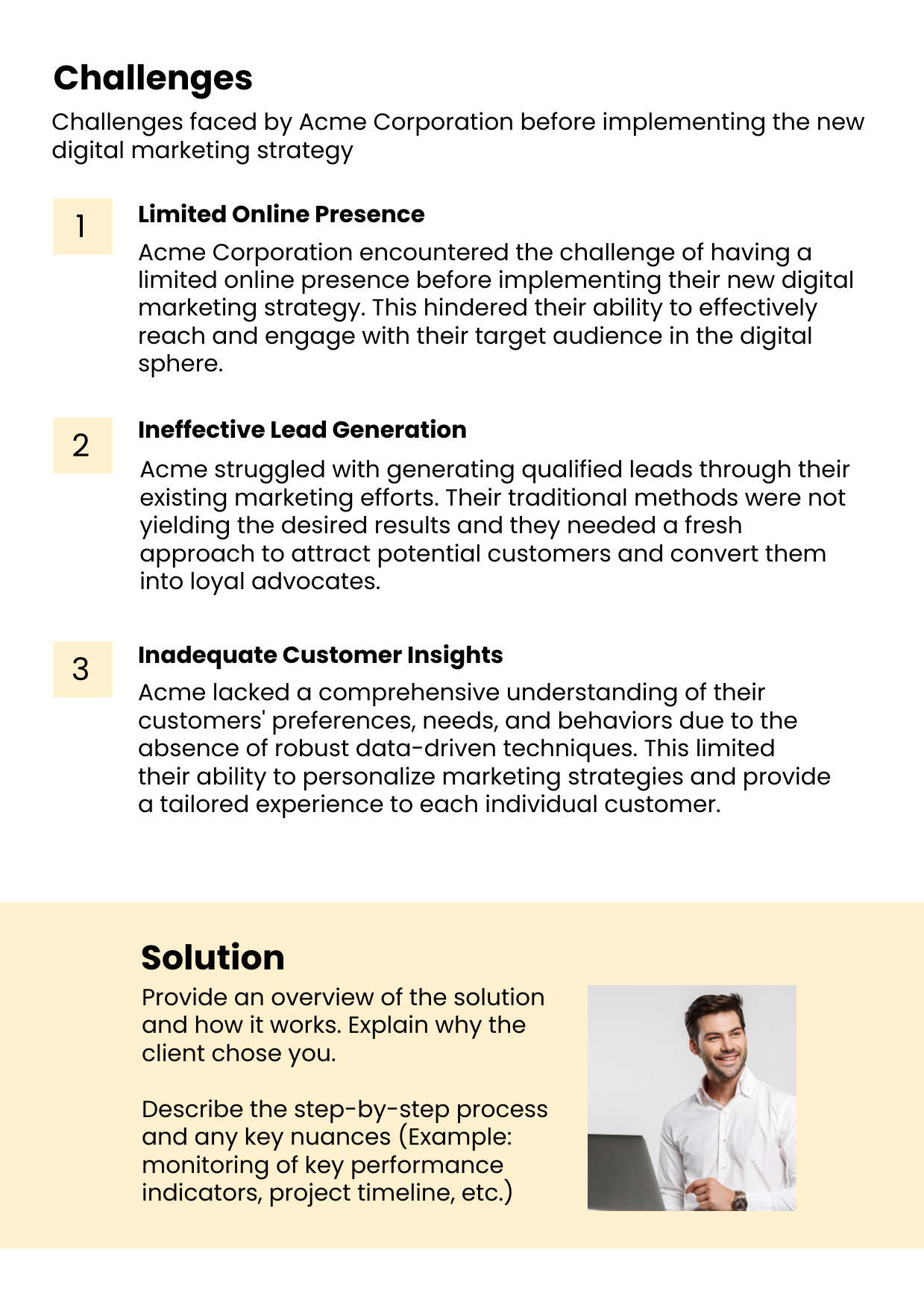
These templates make it a breeze to craft a case study that’s perfect for your niche.
9. Use Direct Quotes from the Client
Quotes from your client add authenticity and credibility. They give readers insight into the client’s perspective and make your case study more relatable. Plus, a glowing testimonial is always a nice touch!
The following inbound marketing case study has a prominent client testimonial. With the brief instructions on this template, it’s easier for you to understand how to capture the golden words of your client and use them as a word-of-mouth strategy within the case study.
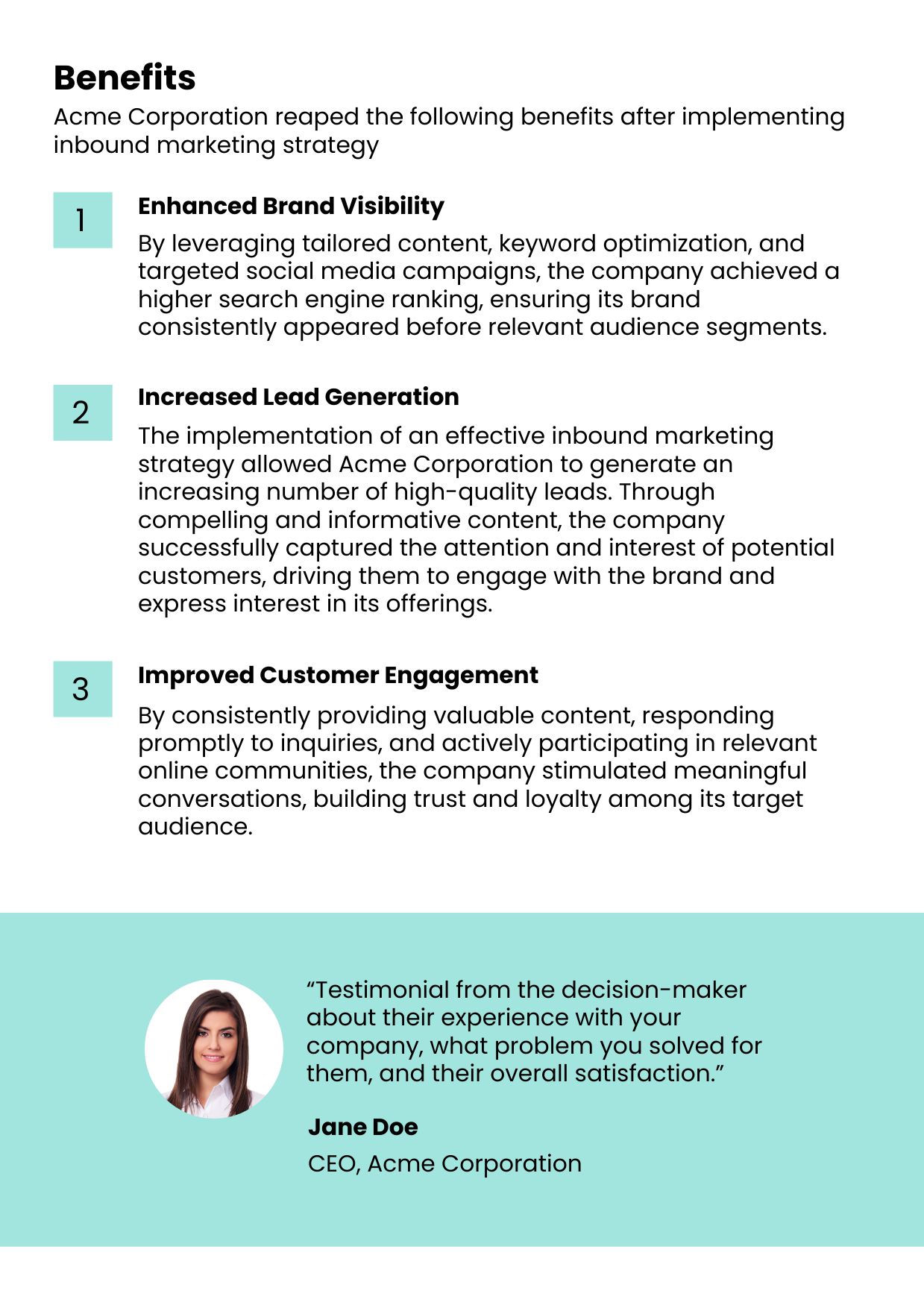
10. Pick an Interesting Angle
Find a unique angle that makes your case study stand out. Maybe it’s an unexpected challenge you overcame, or perhaps it’s a particularly innovative solution. Whatever it is, make it intriguing.
11. Make the Key Takeaway Crystal Clear
Your readers should walk away with a clear understanding of the main point of your case study. This takeaway should reinforce your expertise and the value of your solution.
12. Include a Call to Action (CTA)
Don’t leave your readers hanging—tell them what to do next! Include a compelling summary about your company, showcase your happy client base, and conclude the journey with a strong CTA, whether to contact you for a consultation, download a related resource, or learn more about your services on social media, like the following case study template design.
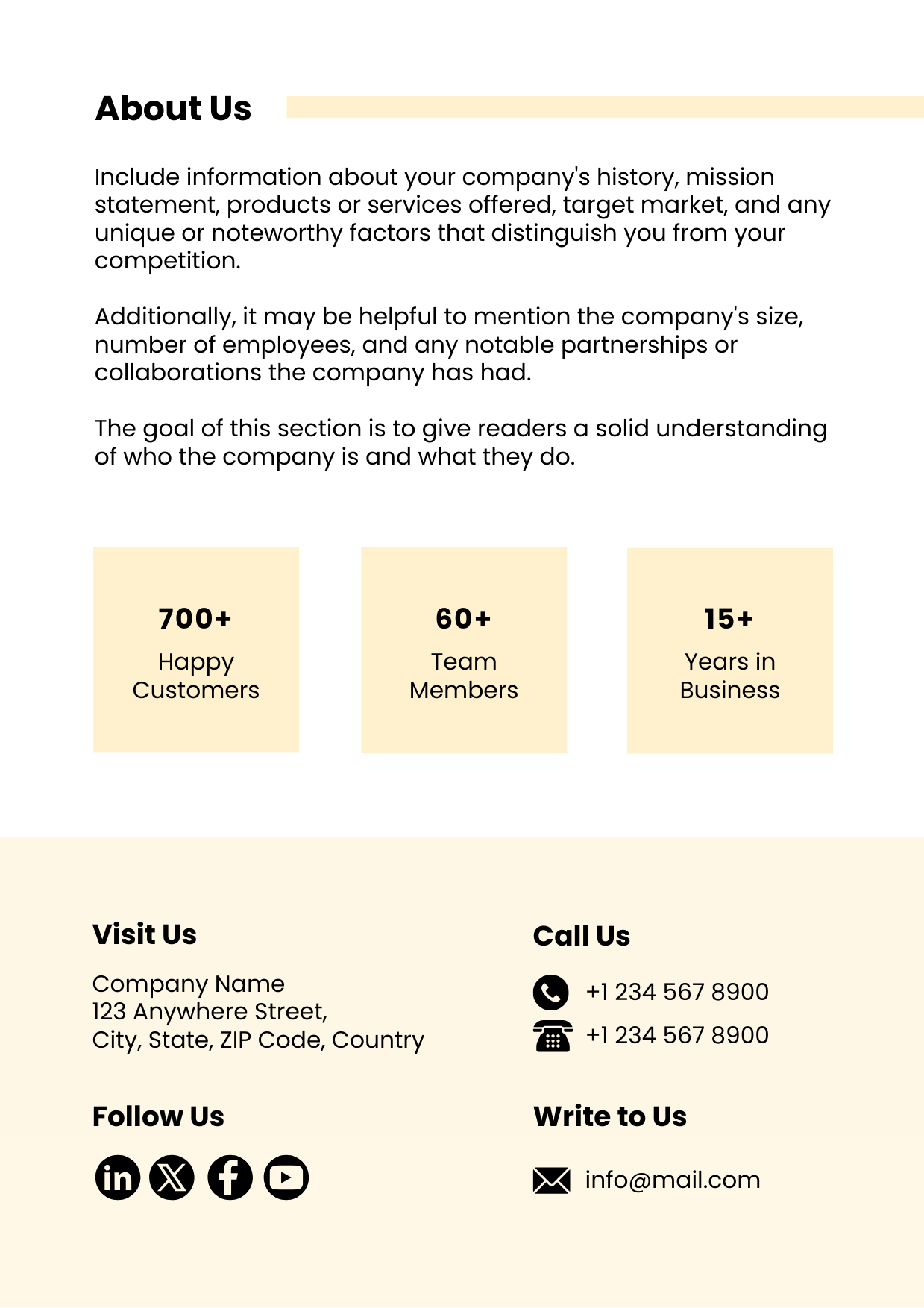
12. Format Professionally
The design of the case study is just as important as the content. A well-formatted, visually appealing document makes a great impression and enhances readability. With ready-to-use niche-oriented templates, you can easily create a professional-looking case study that impresses and converts. Here is an eye-catching template for an AI assistant software case study that displays a sleek and well-navigated format.

13. Make It Readable
Easy readability is key. Use simple language, short paragraphs, and bullet points where appropriate. Your case study should be easy to scan and digest. Follow the thirteen design principles to create a standout piece that enhances your marketing efforts.
To understand this, take a look at the following consulting case study template.

14. Finalize and Proofread Your Case Study
In order to excel in how to write case studies, give your case study a final review before you hit publish. Proofread carefully to catch any typos or errors, and make sure everything flows smoothly. A polished case study reflects your attention to detail and professionalism.
To effectively summarize a case study, start by completing all sections, including the introduction, challenges, solutions, and results. This approach helps marketers identify key points to highlight, making it easier to craft a succinct and engaging summary.
One tricky thing is the length of the case study summary. So, how long should a case study summary be?
The length of a case study summary can vary depending on the details you’re covering. Generally, it should be kept concise, usually spanning a couple of lines or up to a single page with several paragraphs. If you’re crafting a customer case study and want to flex your storytelling muscles, it’s perfectly fine for the summary to stretch to a full page.
If summarizing a case study seems daunting, try DocHipo’s advanced AI Writer tool, which effortlessly creates a crisp and concise summary.
Watch this short video to use it.
This is the last step in writing a case study analysis. Citation in a case study is the practice of giving proper credit to the sources you reference or use in your research. It helps validate your work, shows the depth of your research, and avoids plagiarism. Follow the below steps to cite a case study:
- Identify the Source: Gather details like the author, title, publication year, and where the case study was published.
- Choose a Citation Style: Follow the specific formatting style (APA, MLA, Chicago, etc.) required for your work.
- Format the Citation: Arrange the details according to the chosen citation style.
- Include In-Text Citations: Place citations within the text or paragraphs for the case study.
- Create a References List: At the end of your case study, compile all your sources in a bibliography or reference list.
For case studies, citations in APA and MLA styles are very common. If you are just beginning, then you might be confused about these case study citation formats.
Hence, take a look at the picture below, which easily comprehends the APA vs MLA citation features.
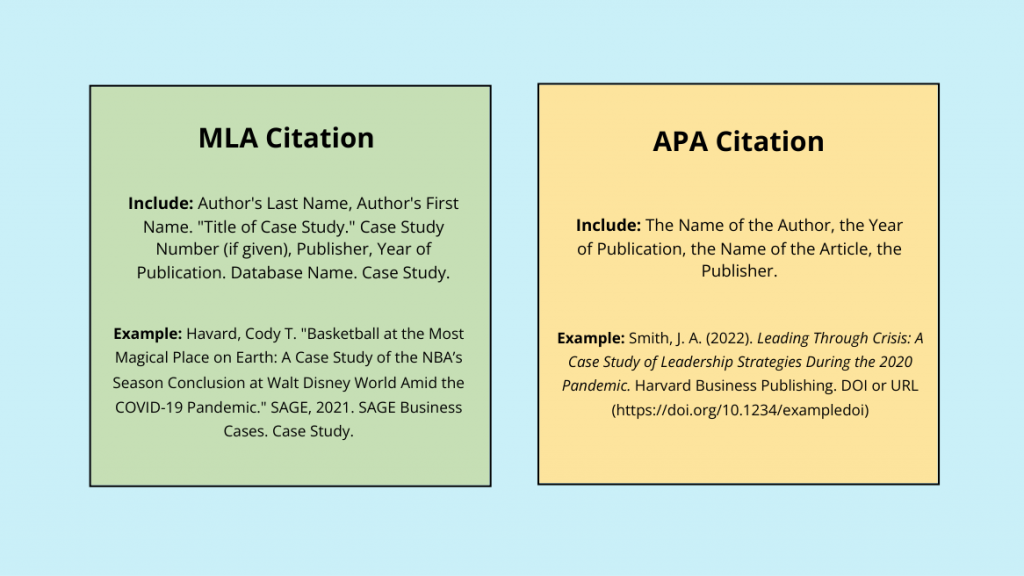
Still feeling overwhelmed about case studies? Be stress-free with the most convenient case study maker, which saves time and allows you to present data in the most attention-grabbing way.
Watch the video to create case studies in minutes with DocHipo’s case study maker.
Conclusion
To summarize, if you want to write a case study, start with a proper case study format, plan the case study, and finally write it with all the information in hand. Then, write a summary to provide an overview of your case study, and finally, add citations for reference.
Meanwhile, if you want to design a case study, Try DocHipo templates. Sign up to explore all the case study templates.
What is the structure of a case study?
A case study typically includes the following sections: Title, Introduction, Background, Problem Statement, Solutions, Results, and Conclusion. Each section serves to tell a comprehensive story of the business, from the issue at hand to the resolution and outcomes.
What are the 5 essential elements of a great case study?
The 5 essential elements are: 1) Clear Objective, 2) Detailed Background, 3) Specific Challenges, 4) Effective Solutions, and 5) Measurable Results. These components provide a compelling narrative that highlights the value delivered.
How to begin a case study?
Start a case study by defining the purpose and scope of the study. Introduce the subject, outline the problem, and provide background information to give readers context. This sets the stage for the detailed analysis that follows.
How to make an introduction in case study?
To craft a compelling introduction, briefly describe the subject, outline the problem they faced, and explain why the study is relevant. This section should grab the reader’s attention and make them interested in the rest of the study.
How to make a business case study?
A business case study should begin with a clear objective and background information. Identify the problem, explain the solutions implemented, and conclude with the results achieved. Use real data and quotes from stakeholders to enhance credibility.
How to write a case study step by step?
To write a case study step by step, start by identifying the case you want to explore and gathering relevant data on the subject. Outline the structure of your case study, then craft an engaging Introduction to set the context. Next, detail the Background and Challenges faced, followed by the Solutions applied. Share the Results and Conclusion to highlight the impact. Finally, edit and proofread your case study to ensure clarity and accuracy.

Turn your ideas into beautiful design
No prior design skill required

Talk to Sales
Wherever you are on your Dochipo journey, you can always get in touch.

Talk to Support
How to Write a Case Study in APA Format
Table of contents
- 1 What Is a Case Study In APA Format?
- 2.1 Sample Of APA Case Study Outline
- 3.1 Title Page in APA for Case Study Project
- 3.2 APA Title Page Example
- 3.3 The Abstract for an APA case study
Whether you study social sciences or life sciences, you’re likely to encounter a case study analysis in your academic journey. These papers demand a lot from students. First, you must have impeccable research and analysis skills. Sample populations, particularly people, can be challenging to analyze. It’s easy to misinterpret data and come up with the wrong conclusions. Additionally, you’ll need to have a knack for writing to present your findings persuasively, backed up by evidence-based arguments that build confidence for your teacher to accept the results of your work. If you need to boost your paper, Papers Owl is here to help you with a wide range of guidelines on how to write a case study in APA.
What Is a Case Study In APA Format?
To make your success, first realize that a case study is detective work. Your research may have an unresolved question or to carry out some testing to validate a hypothesis; in this case, studies are born. Psychology, nursing, and business are common fields this method is applied. In this scientific method, you’ll approach an event, action, individual, etc. And apply a set of circumstances to observe outcomes. Most papers in this field are written in the APA format, which can be a burden for students, especially if they aren’t familiar with this style. If you lack time or motivation for writing, appeal to our professional writers to write a case study in APA format, and we will ensure your paper is perfectly formatted and gets a high grade.
Structure of Case Study Report In APA
First, let’s look at the sections in writing a case study in APA, which shares a few similarities to a typical research paper.
Introduction: Introduce your topic to the reader. Be sure to include the state of current research and where you plan to develop the current state of knowledge. You should include an interesting fact to reinforce your work’s importance and develop an interest in your hypothesis. Finish off with a thesis statement that you’ll focus on your workaround.
Aims: In this section, you answer the questions regarding why you are conducting your research and any questions you’ll explore. Avid case study writer recommends focusing your questions around your thesis. You can develop a triangle with a diagram and drill down your questions in a logical format that matches your paper’s main purpose.
Methods: Writing a case study in APA requires a methods section that details how you conducted your research. Did you conduct any interviews, send out questionnaires, or observe any behaviors? Detail them in this section, and state the environment and circumstances surrounding your data collection.
Results: Now that you’ve identified what you’d planned to accomplish and how you went about it in your APA case study format, it’s time to post the results. Don’t be shy if things don’t go swimmingly. Often in studies, we have unexpected results, which sometimes makes your paper more interesting to read.
Discussion: It’s time for the heart and soul of your paper. After all your research and observation, it is time to have a discourse on the results. The key to how to write a case paper in APA hangs on your ability to interpret the results in a meaningful way. Be sure to focus the discussion on your stated methods and how they pertain to your aims.
Recommendations: Here you want to detail what is to follow your research. Professional case study writers advise stating any knowledge gaps in your work and any unanswered or new questions you had found in the process. Your insights will be useful for others to follow in your footsteps and expand on your analysis.
Sample Of APA Case Study Outline
Example of writing a case study analysis in APA format:
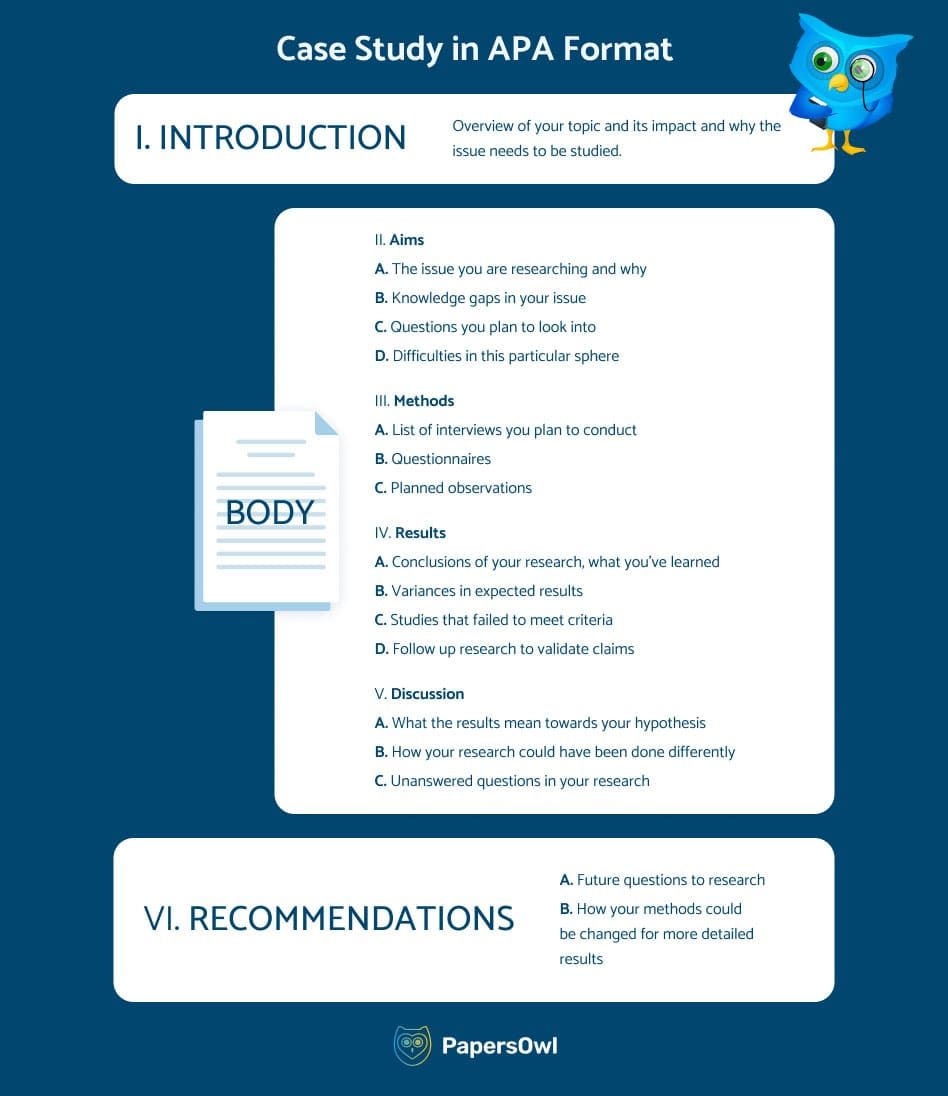
Writing a case study in APA Step By Step
Knowing how to write a case study in APA format is a common question for students. In addition to the typical academic standards, APA has its own requirements that must be adhered to. The first step is to create a heading, known as a running head, that will be present on each page of your paper. The running head includes:
- The page number on the right margin
- A shortened title of your paper in ALL-CAPS no longer than 50 characters to the right
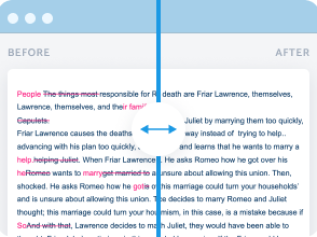
Title Page in APA for Case Study Project
The title of a case study in an APA paper is a requirement. The purpose is to state the name of the work, who the author is, and the institution that sponsored the research. It has the following parts:
- The words “running head” at the top, followed by the actual running head
- The full title of your paper using APA titling no longer than 12 words
- Your name without any designations (Dr/Ph.D./Rev/etc.) and the institution you attend
For APA Style ( 7th edition ), the cover page should also have:
- A page number at the top right corner.
- The institutional affiliation where the research took place.
- Course information, which is mandatory for student papers.
- The author’s note is optional and usually appears in professional papers.
- Font options have expanded to include Calibri 11, Arial 11, Lucida Sans Unicode 10, Times New Roman 12, or Georgia 11.
- All text on the title page should be double-spaced.
- Center all page contents and capitalize the first letter of significant words.
Note: APA 7 distinguishes between the formatting of title pages for professional and student papers. For instance, professional papers include a running head, while student papers do not necessarily include one.
APA Title Page Example

The Abstract for an APA case study
The abstract of your paper works as a summary to give a brief overview of what it contains. Include the running head at the top; the first line should have the word “abstract” centered. Follow the abstract with 150-250 words summarizing your paper. You may also index some keywords to help find the contents of your work in academic databases. At the end of your summary, indent once, and in italics, indicate keywords related to your work.

Writing an effective college paper requires a lot of planning and formatting to get it done right. Brush up on these guidelines for how to write your paper in APA format . If you need someone to review your work or write any parts of your paper, reach out to our professional writers, who are always willing to lend a hand.
Additionally, with the help of our blog, you can make sure you create a professional PowerPoint presentation that clearly outlines the main points of your paper. If you need help with this, our professional writers can provide guidance.
Readers also enjoyed


WHY WAIT? PLACE AN ORDER RIGHT NOW!
Just fill out the form, press the button, and have no worries!
We use cookies to give you the best experience possible. By continuing we’ll assume you board with our cookie policy.
Case Study Analysis: Examples + How-to Guide & Writing Tips
A case study analysis is a typical assignment in business management courses. The task aims to show high school and college students how to analyze a current situation, determine what problems exist, and develop the best possible strategy to achieve the desired outcome.
Many students feel anxious about writing case analyses because being told to analyze a case study and provide a solution can seem like a big task. That is especially so when working with real-life scenarios. However, you can rest assured writing a case analysis paper is easier than you think. Just keep reading this article and you will find case study examples for students and the advice provided by Custom-writing experts!
- 👣 Main Steps
- 🕵 Preparing the Case
🔬 Analyzing the Case
- 📑 Format & Structure
- 🙅 Things to Avoid
- 🏁 Conclusion
🔗 References
👣 writing a case study analysis: main steps.
Business management is built on case analysis. Every single economic result shows that the methods and instruments employed were either well-timed and expedient, in the event of success, or not, in case of failure. These two options indicate whether the strategy is efficient (and should be followed) or requires corrections (or complete change). Such an approach to the case study will make your writing piece more proficient and valuable for the reader. The following steps will direct your plan for writing a case study analysis.
Step 1: Preliminary work
- Make notes and highlight the numbers and ideas that could be quoted.
- Single out as many problems as you can, and briefly mark their underlying issues. Then make a note of those responsible. In the report, you will use two to five of the problems, so you will have a selection to choose from.
- Outline a possible solution to each of the problems you found. Course readings and outside research shall be used here. Highlight your best and worst solution for further reference.
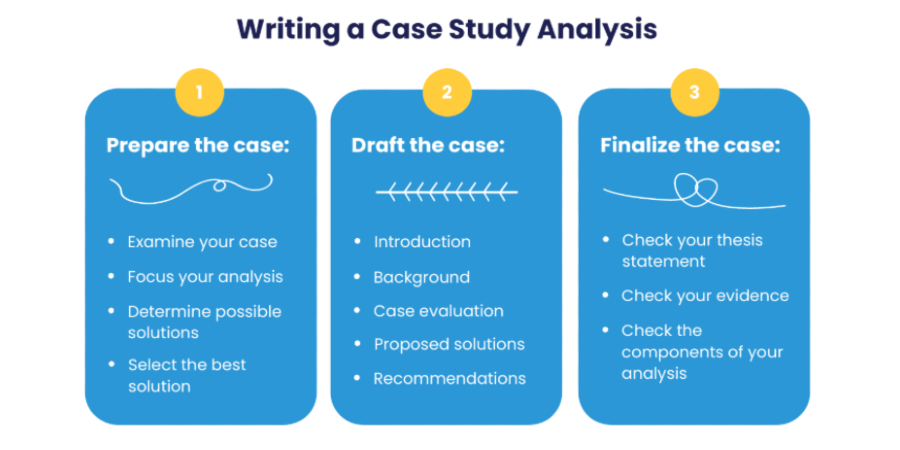
Step 2: Drafting the Case
- Provide a general description of the situation and its history.
- Name all the problems you are going to discuss.
- Specify the theory used for the analysis.
- Present the assumptions that emerged during the analysis, if any.
- Describe the detected problems in more detail.
- Indicate their link to, and effect on, the general situation.
- Explain why the problems emerged and persist.
- List realistic and feasible solutions to the problems you outlined, in the order of importance.
- Specify your predicted results of such changes.
- Support your choice with reliable evidence (i.e., textbook readings, the experience of famous companies, and other external research).
- Define the strategies required to fulfill your proposed solution.
- Indicate the responsible people and the realistic terms for its implementation.
- Recommend the issues for further analysis and supervision.
Step 3: Finalizing the Case
Like any other piece of writing, a case analysis requires post-editing. Carefully read it through, looking for inconsistencies and gaps in meaning. Your purpose is to make it look complete, precise, and convincing.
🕵 Preparing a Case for Analysis
Your professor might give you various case study examples from which to choose, or they may just assign you a particular case study. To conduct a thorough data analysis, you must first read the case study. This might appear to be obvious. However, you’d be surprised at how many students don’t take adequate time to complete this part.
Read the case study very thoroughly, preferably several times. Highlight, underline, flag key information, and make notes to refer to later when you are writing your analysis report.
If you don’t have a complete knowledge of the case study your professor has assigned, you won’t conduct a proper analysis of it. Even if you make use of a business case study template or refer to a sample analysis, it won’t help if you aren’t intimately familiar with your case study.
You will also have to conduct research. When it comes to research, you will need to do the following:
- Gather hard, quantitative data (e.g. 67% of the staff participated in the meeting).
- Design research tools , such as questionnaires and surveys (this will aid in gathering data).
- Determine and suggest the best specific, workable solutions.
It would be best if you also learned how to analyze a case study. Once you have read through the case study, you need to determine the focus of your analysis. You can do this by doing the following:
| Identify | E.g., the loss of brand identity as a problem faced by Starbucks |
| Analyze of the existing problem | |
| Establish between the various factors | Starbucks’ brand image – possible sources of influence: |
| Formulate to address the problem | |
Compare your chosen solutions to the solutions offered by the experts who analyzed the case study you were given or to online assignments for students who were dealing with a similar task. The experts’ solutions will probably be more advanced than yours simply because these people are more experienced. However, don’t let this discourage you; the whole point of doing this analysis is to learn. Use the opportunity to learn from others’ valuable experience, and your results will be better next time.
If you are still in doubt, the University of South Carolina offers a great guide on forming a case study analysis.
📑 Case Analysis Format & Structure
When you are learning how to write a case study analysis, it is important to get the format of your analysis right. Understanding the case study format is vital for both the professor and the student. The person planning and handing out such an assignment should ensure that the student doesn’t have to use any external sources .
In turn, students have to remember that a well-written case analysis provides all the data, making it unnecessary for the reader to go elsewhere for information.
Regardless of whether you use a case study template, you will need to follow a clear and concise format when writing your analysis report. There are some possible case study frameworks available. Still, a case study should contain eight sections laid out in the following format:
- Describe the purpose of the current case study;
- Provide a summary of the company;
- Briefly introduce the problems and issues found in the case study
- Discuss the theory you will be using in the analysis;
- Present the key points of the study and present any assumptions made during the analysis.
- Present each problem you have singled out;
- Justify your inclusion of each problem by providing supporting evidence from the case study and by discussing relevant theory and what you have learned from your course content;
- Divide the section (and following sections) into subsections, one for each of your selected problems.
- Present a summary of each problem you have identified;
- Present plausible solutions for each of the problems, keeping in mind that each problem will likely have more than one possible solution;
- Provide the pros and cons of each solution in a way that is practical.
- Conclusion . This is a summary of your findings and discussion.
- Decide which solution best fits each of the issues you identified;
- Explain why you chose this solution and how it will effectively solve the problem;
- Be persuasive when you write this section so that you can drive your point home;
- Be sure to bring together theory and what you have learned throughout your course to support your recommendations.
- Provide an explanation of what must be done, who should take action, and when the solution should be carried out;
- Where relevant, you should provide an estimate of the cost in implementing the solution, including both the financial investment and the cost in terms of time.
- References. While you generally do not need to refer to many external sources when writing a case study analysis, you might use a few. When you do, you will need to properly reference these sources, which is most often done in one of the main citation styles, including APA, MLA, or Harvard. There is plenty of help when citing references, and you can follow these APA guidelines , these MLA guidelines , or these Harvard guidelines .
- Appendices. This is the section you include after your case study analysis if you used any original data in the report. These data, presented as charts, graphs, and tables, are included here because to present them in the main body of the analysis would be disruptive to the reader. The University of Southern California provides a great description of appendices and when to make use of them.
When you’ve finished your first draft, be sure to proofread it. Look not only for potential grammar and spelling errors but also for discrepancies or holes in your argument.
You should also know what you need to avoid when writing your analysis.
🙅 Things to Avoid in Case Analysis
Whenever you deal with a case study, remember that there are some pitfalls to avoid! Beware of the following mistakes:
- Excessive use of colloquial language . Even though it is a study of an actual case, it should sound formal.
- Lack of statistical data . Give all the important data, both in percentages and in numbers.
- Excessive details. State only the most significant facts, rather than drowning the reader in every fact you find.
- Inconsistency in the methods you have used . In a case study, theory plays a relatively small part, so you must develop a specific case study research methodology.
- Trivial means of research . It is critical that you design your own case study research method in whatever form best suits your analysis, such as questionnaires and surveys.
It is useful to see a few examples of case analysis papers. After all, a sample case study report can provide you with some context so you can see how to approach each aspect of your paper.
👀 Case Study Examples for Students
It might be easier to understand how a case study analysis works if you have an example to look at. Fortunately, examples of case studies are easy to come by. Take a look at this video for a sample case study analysis for the Coca-Cola Company.
If you want another example, then take a look at the one below!
Business Case Analysis: Example
CRM’s primary focus is customers and customer perception of the brand or the company. The focus may shift depending on customers’ needs. The main points that Center Parcs should consider are an increase in customer satisfaction and its market share. Both of these points will enhance customer perception of the product as a product of value. Increased customer satisfaction will indicate that the company provides quality services, and increased market share can reduce the number of switching (or leaving) customers, thus fostering customer loyalty.
Case Study Topics
- Equifax case study: the importance of cybersecurity measures.
- Study a case illustrating ethical issues of medical research.
- Examine the case describing the complications connected with nursing and residential care.
- Analyze the competitive strategy of Delta Airlines .
- Present a case study of an ethical dilemma showing the conflict between the spirit and the letter of the law.
- Explore the aspects of Starbucks’ marketing strategyin a case study.
- Research a case of community-based clinic organization and development.
- Customer service of United Airlines: a case study .
- Analyze a specific schizophrenia case and provide your recommendations.
- Provide a case study of a patient with hyperglycemia.
- Examine the growth strategy of United Healthcare.
- Present a case study demonstrating ethical issues in business.
- Study a case of the 5% shareholding rule application and its impact on the company.
- Case study of post-traumatic stress disorder .
- Analyze a case examining the issues of cross-cultural management .
- Write a case study exploring the ethical issues the finance manager of a long-term care facility can face and the possible reaction to them.
- Write a case study analyzing the aspects of a new president of a firm election.
- Discuss the specifics of supply chain management in the case of Tehindo company.
- Study a case of a life crisis in a family and the ways to cope with it.
- Case study of Tea Leaves and More: supply chain issues.
- Explore the case of ketogenic diet implementation among sportspeople.
- Analyze the case of Webster Jewelry shop and suggest some changes.
- Examine the unique aspects of Tea and More brand management.
- Adidas case study: an ethical dilemma .
- Research the challenges of Brazos Valley Food Bank and suggest possible solutions.
- Describe the case of dark web monitoring for business.
- Study a case of permissive parenting style .
- Case study of Starbucks employees.
- Analyze a case of workplace discrimination and suggest a strategy to avoid it.
- Examine a case of the consumer decision-making process and define the factors that influence it.
- Present a case study of Netflix illustrating the crucial role of management innovation for company development.
- Discuss a case describing a workplace ethical issue and propose ways to resolve it.
- Case study of the 2008 financial crisis: Graham’s value investing principles in the modern economic climate.
- Write a case study analyzing the harmful consequences of communication issues in a virtual team.
- Analyze a case that highlights the importance of a proper functional currency choice.
- Examine the case of Hitachi Power Systems management.
- Present a case study of medication research in a healthcare facility.
- Study the case of Fiji Water and the challenges the brand faces.
- Research a social problem case and suggest a solution.
- Analyze a case that reveals the connection between alcohol use and borderline personality disorder.
- Transglobal Airline case study: break-even analysis.
- Examine the case of Chiquita Brands International from the moral and business ethics points of view.
- Present a case study of applying for Social Security benefits.
- Study the case of a mass hacker attack on Microsoft clients and suggest possible ways to prevent future attacks.
- Case study of leadership effectiveness.
- Analyze a case presenting a clinical moral dilemma and propose ways to resolve it.
- Describe the case of Cowbell Brewing Company and discuss the strategy that made them successful.
- Write a case study of WeWork company and analyze the strengths and weaknesses of its strategy.
- Case study of medical ethical decision-making.
- Study the case of The Georges hotel and suggest ways to overcome its managerial issues.
🏁 Concluding Remarks
Writing a case study analysis can seem incredibly overwhelming, especially if you have never done it before. Just remember, you can do it provided you follow a plan, keep to the format described here, and study at least one case analysis example.
If you still need help analyzing a case study, your professor is always available to answer your questions and point you in the right direction. You can also get help with any aspect of the project from a custom writing company. Just tackle the research and hand over the writing, write a rough draft and have it checked by a professional, or completely hand the project off to an expert writer.
Regardless of the path you choose, you will turn in something of which you can be proud!
✏️ Case Study Analysis FAQ
Students (especially those who study business) often need to write a case study analysis. It is a kind of report that describes a business case. It includes multiple aspects, for example, the problems that exist, possible solutions, forecasts, etc.
There should be 3 main points covered in a case study analysis:
- The challenge(s) description,
- Possible solutions,
- Outcomes (real and/or foreseen).
Firstly, study some examples available online and in the library. Case study analysis should be a well-structured paper with all the integral components in place. Thus, you might want to use a template and/or an outline to start correctly.
A case study analysis is a popular task for business students. They typically hand it in the format of a paper with several integral components:
- Description of the problem
- Possible ways out
- Results and/or forecasts
Students sometimes tell about the outcome of their research within an oral presentation.
- Case Study: Academia
- Windows of vulnerability: a case study analysis (IEEE)
- A (Very) Brief Refresher on the Case Study Method: SAGE
- The case study approach: Medical Research Methodology
- Strengths and Limitations of Case Studies: Stanford University
- A Sample APA Paper: Radford University
- How to Write a Case Study APA Style: Seattle PI
- The Case Analysis: GVSU
- How to Outline: Purdue OWL
- Incorporating Interview Data: UW-Madison Writing Center
- Share to Facebook
- Share to LinkedIn
- Share to email

If you are a student, you might need to learn how to write a literature review at some point. But don’t think it’s the same as the book review or other types of academic writing you had to do in high school! A literature review is a close examination of...

So, have you been recently assigned a research project? Or, even worse, is it already due soon? The following research paper hacks will help you do it in record time. In the article, you’ll see ten things you can do to conduct a study and compose a piece like a...

Eating a delicacy, watching a good movie, and proving a point to an audience are the three things that make life seem better. Today, you’ll deal with the last one. You’re about to become a professional at public speaking and attention grabbing. Here, you can learn how to write a...
![how to set up a case study analysis Library Research Paper: Example & Writing Guide [2024]](https://custom-writing.org/blog/wp-content/uploads/2021/01/library-with-books-284x122.jpeg)
What is a library research paper? It’s nothing more than an academic writing project that summarizes the information on a specific topic taken from primary and secondary sources. There are numerous library research examples you can find online. But to complete this assignment, you should simply follow these essential steps:...
![how to set up a case study analysis Research Analysis Paper: How to Analyze a Research Article [2024]](https://custom-writing.org/blog/wp-content/uploads/2021/01/opened-book-library-table-284x153.jpg)
Do you need to write a research analysis paper but have no idea how to do that? Then you’re in the right place. While completing this type of assignment, your key aim is to critically analyze a research article. An article from a serious scientific journal would be a good...
![how to set up a case study analysis American Antiquity Style Guide: Citation Rules & Examples [2024]](https://custom-writing.org/blog/wp-content/uploads/2020/12/education-concept-books-laptop-library-284x153.jpg)
American Antiquity is a professional quarterly journal, which contains various papers on the American archeology. It is incredibly popular among archeologists and the students majoring in history. The organization adopted the rules of The Society for American Archaeology (SAA) citation style. As a result: The journal includes numerous references that...

The most tedious and time-consuming part of any school or college written assignment is the bibliography. Sometimes, it can even be challenging! For example, if you’re confused by the variety of citation styles. That is why Custom-Writing experts prepared a brief guide about creating a perfect bibliography for a project....

An appendix is the part of the paper that contains supplementary material. The information from an appendix in paper writing is not essential. If the readers ignore this part, they still have to get the paper’s idea. Appendices help the readers to understand the research better. They might be useful...

Writing an abstract is one of the skills you need to master to succeed in your studies. An abstract is a summary of an academic text. It contains information about the aims and the outcomes of the research. The primary purpose of an abstract is to help readers understand what...

So you have to write a literature review. You find your favorite novel and then start analyzing it. This is how it’s usually done, right? It’s not. You have to learn the elements of literature review and how to deal with them.
![how to set up a case study analysis How to Write a Research Paper Step by Step [2024 Upd.]](https://custom-writing.org/blog/wp-content/uploads/2020/12/research-charts-284x153.jpg)
Only two words, but you already feel a chill down your spine. A research paper is no joke. It’s a super detailed piece of academic writing where you analyze a chosen issue in-depth. The main aim of such torture is to show how knowledgeable you are and that your opinion...

A research proposal is a text that suggests a topic or research problem, justifies the need to study it, and describes the ways and methods of conducting the study. Scholars usually write proposals to get funding for their research. In their turn, students might have to do that to get...
Quite an impressive piece The steps and procedures outlined here are well detailed and the examples facilitates understanding.
it was very helpful. I have an assessment to write where in I need to mention different effective components that are needed to compile a high quality case study assessment.
It is very important and helpful.
Thanks a lot. A knowledge shared with a structured template. Stay the course
Thanks for this valuable knowledge.I loved this. keep sharing. to know more about click Air India Case Study – Why Air India failed ?
This is going to be a great help in my monthly analysis requirements for my subject. Thank you so much.
Thank you very much for this insightful guidelines… It has really been a great tool for writing my project. Thanks once again.
This article was very helpful, even though I’ll have a clearer mind only after I do the case study myself but I felt very much motivated after reading this, as now I can at least have a plan of what to do compared to the clueless me I was before I read it. I hope if I have any questions or doubts about doing a case study I can clear it out here.
Organizing Your Social Sciences Research Assignments
- Annotated Bibliography
- Analyzing a Scholarly Journal Article
- Group Presentations
- Dealing with Nervousness
- Using Visual Aids
- Grading Someone Else's Paper
- Types of Structured Group Activities
- Group Project Survival Skills
- Leading a Class Discussion
- Multiple Book Review Essay
- Reviewing Collected Works
- Writing a Case Analysis Paper
- Writing a Case Study
- About Informed Consent
- Writing Field Notes
- Writing a Policy Memo
- Writing a Reflective Paper
- Writing a Research Proposal
- Generative AI and Writing
- Acknowledgments
A case study research paper examines a person, place, event, condition, phenomenon, or other type of subject of analysis in order to extrapolate key themes and results that help predict future trends, illuminate previously hidden issues that can be applied to practice, and/or provide a means for understanding an important research problem with greater clarity. A case study research paper usually examines a single subject of analysis, but case study papers can also be designed as a comparative investigation that shows relationships between two or more subjects. The methods used to study a case can rest within a quantitative, qualitative, or mixed-method investigative paradigm.
Case Studies. Writing@CSU. Colorado State University; Mills, Albert J. , Gabrielle Durepos, and Eiden Wiebe, editors. Encyclopedia of Case Study Research . Thousand Oaks, CA: SAGE Publications, 2010 ; “What is a Case Study?” In Swanborn, Peter G. Case Study Research: What, Why and How? London: SAGE, 2010.
How to Approach Writing a Case Study Research Paper
General information about how to choose a topic to investigate can be found under the " Choosing a Research Problem " tab in the Organizing Your Social Sciences Research Paper writing guide. Review this page because it may help you identify a subject of analysis that can be investigated using a case study design.
However, identifying a case to investigate involves more than choosing the research problem . A case study encompasses a problem contextualized around the application of in-depth analysis, interpretation, and discussion, often resulting in specific recommendations for action or for improving existing conditions. As Seawright and Gerring note, practical considerations such as time and access to information can influence case selection, but these issues should not be the sole factors used in describing the methodological justification for identifying a particular case to study. Given this, selecting a case includes considering the following:
- The case represents an unusual or atypical example of a research problem that requires more in-depth analysis? Cases often represent a topic that rests on the fringes of prior investigations because the case may provide new ways of understanding the research problem. For example, if the research problem is to identify strategies to improve policies that support girl's access to secondary education in predominantly Muslim nations, you could consider using Azerbaijan as a case study rather than selecting a more obvious nation in the Middle East. Doing so may reveal important new insights into recommending how governments in other predominantly Muslim nations can formulate policies that support improved access to education for girls.
- The case provides important insight or illuminate a previously hidden problem? In-depth analysis of a case can be based on the hypothesis that the case study will reveal trends or issues that have not been exposed in prior research or will reveal new and important implications for practice. For example, anecdotal evidence may suggest drug use among homeless veterans is related to their patterns of travel throughout the day. Assuming prior studies have not looked at individual travel choices as a way to study access to illicit drug use, a case study that observes a homeless veteran could reveal how issues of personal mobility choices facilitate regular access to illicit drugs. Note that it is important to conduct a thorough literature review to ensure that your assumption about the need to reveal new insights or previously hidden problems is valid and evidence-based.
- The case challenges and offers a counter-point to prevailing assumptions? Over time, research on any given topic can fall into a trap of developing assumptions based on outdated studies that are still applied to new or changing conditions or the idea that something should simply be accepted as "common sense," even though the issue has not been thoroughly tested in current practice. A case study analysis may offer an opportunity to gather evidence that challenges prevailing assumptions about a research problem and provide a new set of recommendations applied to practice that have not been tested previously. For example, perhaps there has been a long practice among scholars to apply a particular theory in explaining the relationship between two subjects of analysis. Your case could challenge this assumption by applying an innovative theoretical framework [perhaps borrowed from another discipline] to explore whether this approach offers new ways of understanding the research problem. Taking a contrarian stance is one of the most important ways that new knowledge and understanding develops from existing literature.
- The case provides an opportunity to pursue action leading to the resolution of a problem? Another way to think about choosing a case to study is to consider how the results from investigating a particular case may result in findings that reveal ways in which to resolve an existing or emerging problem. For example, studying the case of an unforeseen incident, such as a fatal accident at a railroad crossing, can reveal hidden issues that could be applied to preventative measures that contribute to reducing the chance of accidents in the future. In this example, a case study investigating the accident could lead to a better understanding of where to strategically locate additional signals at other railroad crossings so as to better warn drivers of an approaching train, particularly when visibility is hindered by heavy rain, fog, or at night.
- The case offers a new direction in future research? A case study can be used as a tool for an exploratory investigation that highlights the need for further research about the problem. A case can be used when there are few studies that help predict an outcome or that establish a clear understanding about how best to proceed in addressing a problem. For example, after conducting a thorough literature review [very important!], you discover that little research exists showing the ways in which women contribute to promoting water conservation in rural communities of east central Africa. A case study of how women contribute to saving water in a rural village of Uganda can lay the foundation for understanding the need for more thorough research that documents how women in their roles as cooks and family caregivers think about water as a valuable resource within their community. This example of a case study could also point to the need for scholars to build new theoretical frameworks around the topic [e.g., applying feminist theories of work and family to the issue of water conservation].
Eisenhardt, Kathleen M. “Building Theories from Case Study Research.” Academy of Management Review 14 (October 1989): 532-550; Emmel, Nick. Sampling and Choosing Cases in Qualitative Research: A Realist Approach . Thousand Oaks, CA: SAGE Publications, 2013; Gerring, John. “What Is a Case Study and What Is It Good for?” American Political Science Review 98 (May 2004): 341-354; Mills, Albert J. , Gabrielle Durepos, and Eiden Wiebe, editors. Encyclopedia of Case Study Research . Thousand Oaks, CA: SAGE Publications, 2010; Seawright, Jason and John Gerring. "Case Selection Techniques in Case Study Research." Political Research Quarterly 61 (June 2008): 294-308.
Structure and Writing Style
The purpose of a paper in the social sciences designed around a case study is to thoroughly investigate a subject of analysis in order to reveal a new understanding about the research problem and, in so doing, contributing new knowledge to what is already known from previous studies. In applied social sciences disciplines [e.g., education, social work, public administration, etc.], case studies may also be used to reveal best practices, highlight key programs, or investigate interesting aspects of professional work.
In general, the structure of a case study research paper is not all that different from a standard college-level research paper. However, there are subtle differences you should be aware of. Here are the key elements to organizing and writing a case study research paper.
I. Introduction
As with any research paper, your introduction should serve as a roadmap for your readers to ascertain the scope and purpose of your study . The introduction to a case study research paper, however, should not only describe the research problem and its significance, but you should also succinctly describe why the case is being used and how it relates to addressing the problem. The two elements should be linked. With this in mind, a good introduction answers these four questions:
- What is being studied? Describe the research problem and describe the subject of analysis [the case] you have chosen to address the problem. Explain how they are linked and what elements of the case will help to expand knowledge and understanding about the problem.
- Why is this topic important to investigate? Describe the significance of the research problem and state why a case study design and the subject of analysis that the paper is designed around is appropriate in addressing the problem.
- What did we know about this topic before I did this study? Provide background that helps lead the reader into the more in-depth literature review to follow. If applicable, summarize prior case study research applied to the research problem and why it fails to adequately address the problem. Describe why your case will be useful. If no prior case studies have been used to address the research problem, explain why you have selected this subject of analysis.
- How will this study advance new knowledge or new ways of understanding? Explain why your case study will be suitable in helping to expand knowledge and understanding about the research problem.
Each of these questions should be addressed in no more than a few paragraphs. Exceptions to this can be when you are addressing a complex research problem or subject of analysis that requires more in-depth background information.
II. Literature Review
The literature review for a case study research paper is generally structured the same as it is for any college-level research paper. The difference, however, is that the literature review is focused on providing background information and enabling historical interpretation of the subject of analysis in relation to the research problem the case is intended to address . This includes synthesizing studies that help to:
- Place relevant works in the context of their contribution to understanding the case study being investigated . This would involve summarizing studies that have used a similar subject of analysis to investigate the research problem. If there is literature using the same or a very similar case to study, you need to explain why duplicating past research is important [e.g., conditions have changed; prior studies were conducted long ago, etc.].
- Describe the relationship each work has to the others under consideration that informs the reader why this case is applicable . Your literature review should include a description of any works that support using the case to investigate the research problem and the underlying research questions.
- Identify new ways to interpret prior research using the case study . If applicable, review any research that has examined the research problem using a different research design. Explain how your use of a case study design may reveal new knowledge or a new perspective or that can redirect research in an important new direction.
- Resolve conflicts amongst seemingly contradictory previous studies . This refers to synthesizing any literature that points to unresolved issues of concern about the research problem and describing how the subject of analysis that forms the case study can help resolve these existing contradictions.
- Point the way in fulfilling a need for additional research . Your review should examine any literature that lays a foundation for understanding why your case study design and the subject of analysis around which you have designed your study may reveal a new way of approaching the research problem or offer a perspective that points to the need for additional research.
- Expose any gaps that exist in the literature that the case study could help to fill . Summarize any literature that not only shows how your subject of analysis contributes to understanding the research problem, but how your case contributes to a new way of understanding the problem that prior research has failed to do.
- Locate your own research within the context of existing literature [very important!] . Collectively, your literature review should always place your case study within the larger domain of prior research about the problem. The overarching purpose of reviewing pertinent literature in a case study paper is to demonstrate that you have thoroughly identified and synthesized prior studies in relation to explaining the relevance of the case in addressing the research problem.
III. Method
In this section, you explain why you selected a particular case [i.e., subject of analysis] and the strategy you used to identify and ultimately decide that your case was appropriate in addressing the research problem. The way you describe the methods used varies depending on the type of subject of analysis that constitutes your case study.
If your subject of analysis is an incident or event . In the social and behavioral sciences, the event or incident that represents the case to be studied is usually bounded by time and place, with a clear beginning and end and with an identifiable location or position relative to its surroundings. The subject of analysis can be a rare or critical event or it can focus on a typical or regular event. The purpose of studying a rare event is to illuminate new ways of thinking about the broader research problem or to test a hypothesis. Critical incident case studies must describe the method by which you identified the event and explain the process by which you determined the validity of this case to inform broader perspectives about the research problem or to reveal new findings. However, the event does not have to be a rare or uniquely significant to support new thinking about the research problem or to challenge an existing hypothesis. For example, Walo, Bull, and Breen conducted a case study to identify and evaluate the direct and indirect economic benefits and costs of a local sports event in the City of Lismore, New South Wales, Australia. The purpose of their study was to provide new insights from measuring the impact of a typical local sports event that prior studies could not measure well because they focused on large "mega-events." Whether the event is rare or not, the methods section should include an explanation of the following characteristics of the event: a) when did it take place; b) what were the underlying circumstances leading to the event; and, c) what were the consequences of the event in relation to the research problem.
If your subject of analysis is a person. Explain why you selected this particular individual to be studied and describe what experiences they have had that provide an opportunity to advance new understandings about the research problem. Mention any background about this person which might help the reader understand the significance of their experiences that make them worthy of study. This includes describing the relationships this person has had with other people, institutions, and/or events that support using them as the subject for a case study research paper. It is particularly important to differentiate the person as the subject of analysis from others and to succinctly explain how the person relates to examining the research problem [e.g., why is one politician in a particular local election used to show an increase in voter turnout from any other candidate running in the election]. Note that these issues apply to a specific group of people used as a case study unit of analysis [e.g., a classroom of students].
If your subject of analysis is a place. In general, a case study that investigates a place suggests a subject of analysis that is unique or special in some way and that this uniqueness can be used to build new understanding or knowledge about the research problem. A case study of a place must not only describe its various attributes relevant to the research problem [e.g., physical, social, historical, cultural, economic, political], but you must state the method by which you determined that this place will illuminate new understandings about the research problem. It is also important to articulate why a particular place as the case for study is being used if similar places also exist [i.e., if you are studying patterns of homeless encampments of veterans in open spaces, explain why you are studying Echo Park in Los Angeles rather than Griffith Park?]. If applicable, describe what type of human activity involving this place makes it a good choice to study [e.g., prior research suggests Echo Park has more homeless veterans].
If your subject of analysis is a phenomenon. A phenomenon refers to a fact, occurrence, or circumstance that can be studied or observed but with the cause or explanation to be in question. In this sense, a phenomenon that forms your subject of analysis can encompass anything that can be observed or presumed to exist but is not fully understood. In the social and behavioral sciences, the case usually focuses on human interaction within a complex physical, social, economic, cultural, or political system. For example, the phenomenon could be the observation that many vehicles used by ISIS fighters are small trucks with English language advertisements on them. The research problem could be that ISIS fighters are difficult to combat because they are highly mobile. The research questions could be how and by what means are these vehicles used by ISIS being supplied to the militants and how might supply lines to these vehicles be cut off? How might knowing the suppliers of these trucks reveal larger networks of collaborators and financial support? A case study of a phenomenon most often encompasses an in-depth analysis of a cause and effect that is grounded in an interactive relationship between people and their environment in some way.
NOTE: The choice of the case or set of cases to study cannot appear random. Evidence that supports the method by which you identified and chose your subject of analysis should clearly support investigation of the research problem and linked to key findings from your literature review. Be sure to cite any studies that helped you determine that the case you chose was appropriate for examining the problem.
IV. Discussion
The main elements of your discussion section are generally the same as any research paper, but centered around interpreting and drawing conclusions about the key findings from your analysis of the case study. Note that a general social sciences research paper may contain a separate section to report findings. However, in a paper designed around a case study, it is common to combine a description of the results with the discussion about their implications. The objectives of your discussion section should include the following:
Reiterate the Research Problem/State the Major Findings Briefly reiterate the research problem you are investigating and explain why the subject of analysis around which you designed the case study were used. You should then describe the findings revealed from your study of the case using direct, declarative, and succinct proclamation of the study results. Highlight any findings that were unexpected or especially profound.
Explain the Meaning of the Findings and Why They are Important Systematically explain the meaning of your case study findings and why you believe they are important. Begin this part of the section by repeating what you consider to be your most important or surprising finding first, then systematically review each finding. Be sure to thoroughly extrapolate what your analysis of the case can tell the reader about situations or conditions beyond the actual case that was studied while, at the same time, being careful not to misconstrue or conflate a finding that undermines the external validity of your conclusions.
Relate the Findings to Similar Studies No study in the social sciences is so novel or possesses such a restricted focus that it has absolutely no relation to previously published research. The discussion section should relate your case study results to those found in other studies, particularly if questions raised from prior studies served as the motivation for choosing your subject of analysis. This is important because comparing and contrasting the findings of other studies helps support the overall importance of your results and it highlights how and in what ways your case study design and the subject of analysis differs from prior research about the topic.
Consider Alternative Explanations of the Findings Remember that the purpose of social science research is to discover and not to prove. When writing the discussion section, you should carefully consider all possible explanations revealed by the case study results, rather than just those that fit your hypothesis or prior assumptions and biases. Be alert to what the in-depth analysis of the case may reveal about the research problem, including offering a contrarian perspective to what scholars have stated in prior research if that is how the findings can be interpreted from your case.
Acknowledge the Study's Limitations You can state the study's limitations in the conclusion section of your paper but describing the limitations of your subject of analysis in the discussion section provides an opportunity to identify the limitations and explain why they are not significant. This part of the discussion section should also note any unanswered questions or issues your case study could not address. More detailed information about how to document any limitations to your research can be found here .
Suggest Areas for Further Research Although your case study may offer important insights about the research problem, there are likely additional questions related to the problem that remain unanswered or findings that unexpectedly revealed themselves as a result of your in-depth analysis of the case. Be sure that the recommendations for further research are linked to the research problem and that you explain why your recommendations are valid in other contexts and based on the original assumptions of your study.
V. Conclusion
As with any research paper, you should summarize your conclusion in clear, simple language; emphasize how the findings from your case study differs from or supports prior research and why. Do not simply reiterate the discussion section. Provide a synthesis of key findings presented in the paper to show how these converge to address the research problem. If you haven't already done so in the discussion section, be sure to document the limitations of your case study and any need for further research.
The function of your paper's conclusion is to: 1) reiterate the main argument supported by the findings from your case study; 2) state clearly the context, background, and necessity of pursuing the research problem using a case study design in relation to an issue, controversy, or a gap found from reviewing the literature; and, 3) provide a place to persuasively and succinctly restate the significance of your research problem, given that the reader has now been presented with in-depth information about the topic.
Consider the following points to help ensure your conclusion is appropriate:
- If the argument or purpose of your paper is complex, you may need to summarize these points for your reader.
- If prior to your conclusion, you have not yet explained the significance of your findings or if you are proceeding inductively, use the conclusion of your paper to describe your main points and explain their significance.
- Move from a detailed to a general level of consideration of the case study's findings that returns the topic to the context provided by the introduction or within a new context that emerges from your case study findings.
Note that, depending on the discipline you are writing in or the preferences of your professor, the concluding paragraph may contain your final reflections on the evidence presented as it applies to practice or on the essay's central research problem. However, the nature of being introspective about the subject of analysis you have investigated will depend on whether you are explicitly asked to express your observations in this way.
Problems to Avoid
Overgeneralization One of the goals of a case study is to lay a foundation for understanding broader trends and issues applied to similar circumstances. However, be careful when drawing conclusions from your case study. They must be evidence-based and grounded in the results of the study; otherwise, it is merely speculation. Looking at a prior example, it would be incorrect to state that a factor in improving girls access to education in Azerbaijan and the policy implications this may have for improving access in other Muslim nations is due to girls access to social media if there is no documentary evidence from your case study to indicate this. There may be anecdotal evidence that retention rates were better for girls who were engaged with social media, but this observation would only point to the need for further research and would not be a definitive finding if this was not a part of your original research agenda.
Failure to Document Limitations No case is going to reveal all that needs to be understood about a research problem. Therefore, just as you have to clearly state the limitations of a general research study , you must describe the specific limitations inherent in the subject of analysis. For example, the case of studying how women conceptualize the need for water conservation in a village in Uganda could have limited application in other cultural contexts or in areas where fresh water from rivers or lakes is plentiful and, therefore, conservation is understood more in terms of managing access rather than preserving access to a scarce resource.
Failure to Extrapolate All Possible Implications Just as you don't want to over-generalize from your case study findings, you also have to be thorough in the consideration of all possible outcomes or recommendations derived from your findings. If you do not, your reader may question the validity of your analysis, particularly if you failed to document an obvious outcome from your case study research. For example, in the case of studying the accident at the railroad crossing to evaluate where and what types of warning signals should be located, you failed to take into consideration speed limit signage as well as warning signals. When designing your case study, be sure you have thoroughly addressed all aspects of the problem and do not leave gaps in your analysis that leave the reader questioning the results.
Case Studies. Writing@CSU. Colorado State University; Gerring, John. Case Study Research: Principles and Practices . New York: Cambridge University Press, 2007; Merriam, Sharan B. Qualitative Research and Case Study Applications in Education . Rev. ed. San Francisco, CA: Jossey-Bass, 1998; Miller, Lisa L. “The Use of Case Studies in Law and Social Science Research.” Annual Review of Law and Social Science 14 (2018): TBD; Mills, Albert J., Gabrielle Durepos, and Eiden Wiebe, editors. Encyclopedia of Case Study Research . Thousand Oaks, CA: SAGE Publications, 2010; Putney, LeAnn Grogan. "Case Study." In Encyclopedia of Research Design , Neil J. Salkind, editor. (Thousand Oaks, CA: SAGE Publications, 2010), pp. 116-120; Simons, Helen. Case Study Research in Practice . London: SAGE Publications, 2009; Kratochwill, Thomas R. and Joel R. Levin, editors. Single-Case Research Design and Analysis: New Development for Psychology and Education . Hilldsale, NJ: Lawrence Erlbaum Associates, 1992; Swanborn, Peter G. Case Study Research: What, Why and How? London : SAGE, 2010; Yin, Robert K. Case Study Research: Design and Methods . 6th edition. Los Angeles, CA, SAGE Publications, 2014; Walo, Maree, Adrian Bull, and Helen Breen. “Achieving Economic Benefits at Local Events: A Case Study of a Local Sports Event.” Festival Management and Event Tourism 4 (1996): 95-106.
Writing Tip
At Least Five Misconceptions about Case Study Research
Social science case studies are often perceived as limited in their ability to create new knowledge because they are not randomly selected and findings cannot be generalized to larger populations. Flyvbjerg examines five misunderstandings about case study research and systematically "corrects" each one. To quote, these are:
Misunderstanding 1 : General, theoretical [context-independent] knowledge is more valuable than concrete, practical [context-dependent] knowledge. Misunderstanding 2 : One cannot generalize on the basis of an individual case; therefore, the case study cannot contribute to scientific development. Misunderstanding 3 : The case study is most useful for generating hypotheses; that is, in the first stage of a total research process, whereas other methods are more suitable for hypotheses testing and theory building. Misunderstanding 4 : The case study contains a bias toward verification, that is, a tendency to confirm the researcher’s preconceived notions. Misunderstanding 5 : It is often difficult to summarize and develop general propositions and theories on the basis of specific case studies [p. 221].
While writing your paper, think introspectively about how you addressed these misconceptions because to do so can help you strengthen the validity and reliability of your research by clarifying issues of case selection, the testing and challenging of existing assumptions, the interpretation of key findings, and the summation of case outcomes. Think of a case study research paper as a complete, in-depth narrative about the specific properties and key characteristics of your subject of analysis applied to the research problem.
Flyvbjerg, Bent. “Five Misunderstandings About Case-Study Research.” Qualitative Inquiry 12 (April 2006): 219-245.
- << Previous: Writing a Case Analysis Paper
- Next: Writing a Field Report >>
- Last Updated: Jun 3, 2024 9:44 AM
- URL: https://libguides.usc.edu/writingguide/assignments
How to Write a Case Study - All You Wanted to Know

What do you study in your college? If you are a psychology, sociology, or anthropology student, we bet you might be familiar with what a case study is. This research method is used to study a certain person, group, or situation. In this guide from our dissertation writing service , you will learn how to write a case study professionally, from researching to citing sources properly. Also, we will explore different types of case studies and show you examples — so that you won’t have any other questions left.
What Is a Case Study?
A case study is a subcategory of research design which investigates problems and offers solutions. Case studies can range from academic research studies to corporate promotional tools trying to sell an idea—their scope is quite vast.
What Is the Difference Between a Research Paper and a Case Study?
While research papers turn the reader’s attention to a certain problem, case studies go even further. Case study guidelines require students to pay attention to details, examining issues closely and in-depth using different research methods. For example, case studies may be used to examine court cases if you study Law, or a patient's health history if you study Medicine. Case studies are also used in Marketing, which are thorough, empirically supported analysis of a good or service's performance. Well-designed case studies can be valuable for prospective customers as they can identify and solve the potential customers pain point.
Case studies involve a lot of storytelling – they usually examine particular cases for a person or a group of people. This method of research is very helpful, as it is very practical and can give a lot of hands-on information. Most commonly, the length of the case study is about 500-900 words, which is much less than the length of an average research paper.
The structure of a case study is very similar to storytelling. It has a protagonist or main character, which in your case is actually a problem you are trying to solve. You can use the system of 3 Acts to make it a compelling story. It should have an introduction, rising action, a climax where transformation occurs, falling action, and a solution.
Here is a rough formula for you to use in your case study:
Problem (Act I): > Solution (Act II) > Result (Act III) > Conclusion.
Types of Case Studies
The purpose of a case study is to provide detailed reports on an event, an institution, a place, future customers, or pretty much anything. There are a few common types of case study, but the type depends on the topic. The following are the most common domains where case studies are needed:

- Historical case studies are great to learn from. Historical events have a multitude of source info offering different perspectives. There are always modern parallels where these perspectives can be applied, compared, and thoroughly analyzed.
- Problem-oriented case studies are usually used for solving problems. These are often assigned as theoretical situations where you need to immerse yourself in the situation to examine it. Imagine you’re working for a startup and you’ve just noticed a significant flaw in your product’s design. Before taking it to the senior manager, you want to do a comprehensive study on the issue and provide solutions. On a greater scale, problem-oriented case studies are a vital part of relevant socio-economic discussions.
- Cumulative case studies collect information and offer comparisons. In business, case studies are often used to tell people about the value of a product.
- Critical case studies explore the causes and effects of a certain case.
- Illustrative case studies describe certain events, investigating outcomes and lessons learned.
Need a compelling case study? EssayPro has got you covered. Our experts are ready to provide you with detailed, insightful case studies that capture the essence of real-world scenarios. Elevate your academic work with our professional assistance.

Case Study Format
The case study format is typically made up of eight parts:
- Executive Summary. Explain what you will examine in the case study. Write an overview of the field you’re researching. Make a thesis statement and sum up the results of your observation in a maximum of 2 sentences.
- Background. Provide background information and the most relevant facts. Isolate the issues.
- Case Evaluation. Isolate the sections of the study you want to focus on. In it, explain why something is working or is not working.
- Proposed Solutions. Offer realistic ways to solve what isn’t working or how to improve its current condition. Explain why these solutions work by offering testable evidence.
- Conclusion. Summarize the main points from the case evaluations and proposed solutions. 6. Recommendations. Talk about the strategy that you should choose. Explain why this choice is the most appropriate.
- Implementation. Explain how to put the specific strategies into action.
- References. Provide all the citations.
How to Write a Case Study
Let's discover how to write a case study.

Setting Up the Research
When writing a case study, remember that research should always come first. Reading many different sources and analyzing other points of view will help you come up with more creative solutions. You can also conduct an actual interview to thoroughly investigate the customer story that you'll need for your case study. Including all of the necessary research, writing a case study may take some time. The research process involves doing the following:
- Define your objective. Explain the reason why you’re presenting your subject. Figure out where you will feature your case study; whether it is written, on video, shown as an infographic, streamed as a podcast, etc.
- Determine who will be the right candidate for your case study. Get permission, quotes, and other features that will make your case study effective. Get in touch with your candidate to see if they approve of being part of your work. Study that candidate’s situation and note down what caused it.
- Identify which various consequences could result from the situation. Follow these guidelines on how to start a case study: surf the net to find some general information you might find useful.
- Make a list of credible sources and examine them. Seek out important facts and highlight problems. Always write down your ideas and make sure to brainstorm.
- Focus on several key issues – why they exist, and how they impact your research subject. Think of several unique solutions. Draw from class discussions, readings, and personal experience. When writing a case study, focus on the best solution and explore it in depth. After having all your research in place, writing a case study will be easy. You may first want to check the rubric and criteria of your assignment for the correct case study structure.
Read Also: ' WHAT IS A CREDIBLE SOURCES ?'
Although your instructor might be looking at slightly different criteria, every case study rubric essentially has the same standards. Your professor will want you to exhibit 8 different outcomes:
- Correctly identify the concepts, theories, and practices in the discipline.
- Identify the relevant theories and principles associated with the particular study.
- Evaluate legal and ethical principles and apply them to your decision-making.
- Recognize the global importance and contribution of your case.
- Construct a coherent summary and explanation of the study.
- Demonstrate analytical and critical-thinking skills.
- Explain the interrelationships between the environment and nature.
- Integrate theory and practice of the discipline within the analysis.

Wednesday Addams
Mysterious, dark, and sarcastic
You’re the master of dark humor and love standing out with your unconventional style. Your perfect costume? A modern twist on Wednesday Addams’ gothic look. You’ll own Halloween with your unapologetically eerie vibe. 🖤🕸️
Need Case Study DONE FAST?
Pick a topic, tell us your requirements and get your paper on time.
Case Study Outline
Let's look at the structure of an outline based on the issue of the alcoholic addiction of 30 people.
Introduction
- Statement of the issue: Alcoholism is a disease rather than a weakness of character.
- Presentation of the problem: Alcoholism is affecting more than 14 million people in the USA, which makes it the third most common mental illness there.
- Explanation of the terms: In the past, alcoholism was commonly referred to as alcohol dependence or alcohol addiction. Alcoholism is now the more severe stage of this addiction in the disorder spectrum.
- Hypotheses: Drinking in excess can lead to the use of other drugs.
- Importance of your story: How the information you present can help people with their addictions.
- Background of the story: Include an explanation of why you chose this topic.
- Presentation of analysis and data: Describe the criteria for choosing 30 candidates, the structure of the interview, and the outcomes.
- Strong argument 1: ex. X% of candidates dealing with anxiety and depression...
- Strong argument 2: ex. X amount of people started drinking by their mid-teens.
- Strong argument 3: ex. X% of respondents’ parents had issues with alcohol.
- Concluding statement: I have researched if alcoholism is a disease and found out that…
- Recommendations: Ways and actions for preventing alcohol use.
Writing a Case Study Draft
After you’ve done your case study research and written the outline, it’s time to focus on the draft. In a draft, you have to develop and write your case study by using: the data which you collected throughout the research, interviews, and the analysis processes that were undertaken. Follow these rules for the draft:

| 📝 Step | 📌 Description |
|---|---|
| 1. Draft Structure | 🖋️ Your draft should contain at least 4 sections: an introduction; a body where you should include background information, an explanation of why you decided to do this case study, and a presentation of your main findings; a conclusion where you present data; and references. |
| 2. Introduction | 📚 In the introduction, you should set the pace very clearly. You can even raise a question or quote someone you interviewed in the research phase. It must provide adequate background information on the topic. The background may include analyses of previous studies on your topic. Include the aim of your case here as well. Think of it as a thesis statement. The aim must describe the purpose of your work—presenting the issues that you want to tackle. Include background information, such as photos or videos you used when doing the research. |
| 3. Research Process | 🔍 Describe your unique research process, whether it was through interviews, observations, academic journals, etc. The next point includes providing the results of your research. Tell the audience what you found out. Why is this important, and what could be learned from it? Discuss the real implications of the problem and its significance in the world. |
| 4. Quotes and Data | 💬 Include quotes and data (such as findings, percentages, and awards). This will add a personal touch and better credibility to the case you present. Explain what results you find during your interviews in regards to the problem and how it developed. Also, write about solutions which have already been proposed by other people who have already written about this case. |
| 5. Offer Solutions | 💡 At the end of your case study, you should offer possible solutions, but don’t worry about solving them yourself. |
Use Data to Illustrate Key Points in Your Case Study
Even though your case study is a story, it should be based on evidence. Use as much data as possible to illustrate your point. Without the right data, your case study may appear weak and the readers may not be able to relate to your issue as much as they should. Let's see the examples from essay writing service :
With data: Alcoholism is affecting more than 14 million people in the USA, which makes it the third most common mental illness there. Without data: A lot of people suffer from alcoholism in the United States.
Try to include as many credible sources as possible. You may have terms or sources that could be hard for other cultures to understand. If this is the case, you should include them in the appendix or Notes for the Instructor or Professor.
Finalizing the Draft: Checklist
After you finish drafting your case study, polish it up by answering these ‘ask yourself’ questions and think about how to end your case study:
- Check that you follow the correct case study format, also in regards to text formatting.
- Check that your work is consistent with its referencing and citation style.
- Micro-editing — check for grammar and spelling issues.
- Macro-editing — does ‘the big picture’ come across to the reader? Is there enough raw data, such as real-life examples or personal experiences? Have you made your data collection process completely transparent? Does your analysis provide a clear conclusion, allowing for further research and practice?
Problems to avoid:
- Overgeneralization – Do not go into further research that deviates from the main problem.
- Failure to Document Limitations – Just as you have to clearly state the limitations of a general research study, you must describe the specific limitations inherent in the subject of analysis.
- Failure to Extrapolate All Possible Implications – Just as you don't want to over-generalize from your case study findings, you also have to be thorough in the consideration of all possible outcomes or recommendations derived from your findings.
How to Create a Title Page and Cite a Case Study
Let's see how to create an awesome title page.
Your title page depends on the prescribed citation format. The title page should include:
- A title that attracts some attention and describes your study
- The title should have the words “case study” in it
- The title should range between 5-9 words in length
- Your name and contact information
- Your finished paper should be only 500 to 1,500 words in length.With this type of assignment, write effectively and avoid fluff
Here is a template for the APA and MLA format title page:
There are some cases when you need to cite someone else's study in your own one – therefore, you need to master how to cite a case study. A case study is like a research paper when it comes to citations. You can cite it like you cite a book, depending on what style you need.
Citation Example in MLA Hill, Linda, Tarun Khanna, and Emily A. Stecker. HCL Technologies. Boston: Harvard Business Publishing, 2008. Print.
Citation Example in APA Hill, L., Khanna, T., & Stecker, E. A. (2008). HCL Technologies. Boston: Harvard Business Publishing.
Citation Example in Chicago Hill, Linda, Tarun Khanna, and Emily A. Stecker. HCL Technologies.
Case Study Examples
To give you an idea of a professional case study example, we gathered and linked some below.
Eastman Kodak Case Study
Case Study Example: Audi Trains Mexican Autoworkers in Germany
To conclude, a case study is one of the best methods of getting an overview of what happened to a person, a group, or a situation in practice. It allows you to have an in-depth glance at the real-life problems that businesses, healthcare industry, criminal justice, etc. may face. This insight helps us look at such situations in a different light. This is because we see scenarios that we otherwise would not, without necessarily being there. If you need custom essays , try our research paper writing services .
Get Help Form Qualified Writers
Crafting a case study is not easy. You might want to write one of high quality, but you don’t have the time or expertise. If you’re having trouble with your case study, help with essay request - we'll help. EssayPro writers have read and written countless case studies and are experts in endless disciplines. Request essay writing, editing, or proofreading assistance from our custom case study writing service , and all of your worries will be gone.
Don't Know Where to Start?
Crafting a case study is not easy. You might want to write one of high quality, but you don’t have the time or expertise. Request ' write my case study ' assistance from our service.
What Is A Case Study?
How to cite a case study in apa, how to write a case study.

Daniel Parker
is a seasoned educational writer focusing on scholarship guidance, research papers, and various forms of academic essays including reflective and narrative essays. His expertise also extends to detailed case studies. A scholar with a background in English Literature and Education, Daniel’s work on EssayPro blog aims to support students in achieving academic excellence and securing scholarships. His hobbies include reading classic literature and participating in academic forums.

is an expert in nursing and healthcare, with a strong background in history, law, and literature. Holding advanced degrees in nursing and public health, his analytical approach and comprehensive knowledge help students navigate complex topics. On EssayPro blog, Adam provides insightful articles on everything from historical analysis to the intricacies of healthcare policies. In his downtime, he enjoys historical documentaries and volunteering at local clinics.
.webp)
WCU » WCU Student Resources » Research and Writing » Writing a Case Study Analysis

Guidelines for Writing a Case Study Analysis
A case study analysis requires an investigation to a problem. Then, examine the alternative solutions. Next, propose the most effective solution using supporting evidence.
Preparing the Case
Before you begin writing, follow these guidelines to help you prepare and understand the case study:
- Read and examine the case thoroughly Take notes, highlight relevant facts, and underline key problems.
- Focus your analysis Identify key issues. Who or what are responsible?
- Detect solutions Review: course readings, discussions, outside research, and your experience.
- Select solution[s] Consider all supporting evidence, pros, and cons: is this solution genuine?
Drafting the Case
A draft of your analysis should include these sections:
- Introduction Identify the key problems and issues in the case study. • Formulate and include a thesis statement, summarizing the outcome of your analysis in 1–2 sentences.
- Background Set the scene: background information, relevant facts, and the most important issues. Demonstrate that you have researched the problems in this case study.
- Choices Explain why alternatives were rejected or not possible at this time.
- Solution[s] Provide one specific and realistic solution. Explain why this solution was chosen. Support this solution with solid evidence.
- Recommendations Determine and discuss specific strategies for accomplishing the proposed solution. What should be done and who should do it?
Finalizing the Case
Read through your work to check for any gaps or inconsistencies in content. I suggest reading it out loud. It can bring the inconsistencies or gaps to light much faster than reading it in silence to yourself.
WCU Student Resources
- Canvas vs. Blackboard Terminology
- Writing a Case Study Analysis
- My Student Success Advisor
- Technical Requirements for Online Classes
- Virtual Bookstore for Campus Programs
- VitalSource E-Text (Online Programs)
- Student Portal
- Welcome Video
- Why Employers Hire WCU Graduates
Have a language expert improve your writing
Run a free plagiarism check in 10 minutes, generate accurate citations for free.
- Knowledge Base
Methodology
- What Is a Case Study? | Definition, Examples & Methods
What Is a Case Study? | Definition, Examples & Methods
Published on May 8, 2019 by Shona McCombes . Revised on November 20, 2023.
A case study is a detailed study of a specific subject, such as a person, group, place, event, organization, or phenomenon. Case studies are commonly used in social, educational, clinical, and business research.
A case study research design usually involves qualitative methods , but quantitative methods are sometimes also used. Case studies are good for describing , comparing, evaluating and understanding different aspects of a research problem .
Table of contents
When to do a case study, step 1: select a case, step 2: build a theoretical framework, step 3: collect your data, step 4: describe and analyze the case, other interesting articles.
A case study is an appropriate research design when you want to gain concrete, contextual, in-depth knowledge about a specific real-world subject. It allows you to explore the key characteristics, meanings, and implications of the case.
Case studies are often a good choice in a thesis or dissertation . They keep your project focused and manageable when you don’t have the time or resources to do large-scale research.
You might use just one complex case study where you explore a single subject in depth, or conduct multiple case studies to compare and illuminate different aspects of your research problem.
| Research question | Case study |
|---|---|
| What are the ecological effects of wolf reintroduction? | Case study of wolf reintroduction in Yellowstone National Park |
| How do populist politicians use narratives about history to gain support? | Case studies of Hungarian prime minister Viktor Orbán and US president Donald Trump |
| How can teachers implement active learning strategies in mixed-level classrooms? | Case study of a local school that promotes active learning |
| What are the main advantages and disadvantages of wind farms for rural communities? | Case studies of three rural wind farm development projects in different parts of the country |
| How are viral marketing strategies changing the relationship between companies and consumers? | Case study of the iPhone X marketing campaign |
| How do experiences of work in the gig economy differ by gender, race and age? | Case studies of Deliveroo and Uber drivers in London |
Prevent plagiarism. Run a free check.
Once you have developed your problem statement and research questions , you should be ready to choose the specific case that you want to focus on. A good case study should have the potential to:
- Provide new or unexpected insights into the subject
- Challenge or complicate existing assumptions and theories
- Propose practical courses of action to resolve a problem
- Open up new directions for future research
TipIf your research is more practical in nature and aims to simultaneously investigate an issue as you solve it, consider conducting action research instead.
Unlike quantitative or experimental research , a strong case study does not require a random or representative sample. In fact, case studies often deliberately focus on unusual, neglected, or outlying cases which may shed new light on the research problem.
Example of an outlying case studyIn the 1960s the town of Roseto, Pennsylvania was discovered to have extremely low rates of heart disease compared to the US average. It became an important case study for understanding previously neglected causes of heart disease.
However, you can also choose a more common or representative case to exemplify a particular category, experience or phenomenon.
Example of a representative case studyIn the 1920s, two sociologists used Muncie, Indiana as a case study of a typical American city that supposedly exemplified the changing culture of the US at the time.
While case studies focus more on concrete details than general theories, they should usually have some connection with theory in the field. This way the case study is not just an isolated description, but is integrated into existing knowledge about the topic. It might aim to:
- Exemplify a theory by showing how it explains the case under investigation
- Expand on a theory by uncovering new concepts and ideas that need to be incorporated
- Challenge a theory by exploring an outlier case that doesn’t fit with established assumptions
To ensure that your analysis of the case has a solid academic grounding, you should conduct a literature review of sources related to the topic and develop a theoretical framework . This means identifying key concepts and theories to guide your analysis and interpretation.
There are many different research methods you can use to collect data on your subject. Case studies tend to focus on qualitative data using methods such as interviews , observations , and analysis of primary and secondary sources (e.g., newspaper articles, photographs, official records). Sometimes a case study will also collect quantitative data.
Example of a mixed methods case studyFor a case study of a wind farm development in a rural area, you could collect quantitative data on employment rates and business revenue, collect qualitative data on local people’s perceptions and experiences, and analyze local and national media coverage of the development.
The aim is to gain as thorough an understanding as possible of the case and its context.
Here's why students love Scribbr's proofreading services
Discover proofreading & editing
In writing up the case study, you need to bring together all the relevant aspects to give as complete a picture as possible of the subject.
How you report your findings depends on the type of research you are doing. Some case studies are structured like a standard scientific paper or thesis , with separate sections or chapters for the methods , results and discussion .
Others are written in a more narrative style, aiming to explore the case from various angles and analyze its meanings and implications (for example, by using textual analysis or discourse analysis ).
In all cases, though, make sure to give contextual details about the case, connect it back to the literature and theory, and discuss how it fits into wider patterns or debates.
If you want to know more about statistics , methodology , or research bias , make sure to check out some of our other articles with explanations and examples.
- Normal distribution
- Degrees of freedom
- Null hypothesis
- Discourse analysis
- Control groups
- Mixed methods research
- Non-probability sampling
- Quantitative research
- Ecological validity
Research bias
- Rosenthal effect
- Implicit bias
- Cognitive bias
- Selection bias
- Negativity bias
- Status quo bias
Cite this Scribbr article
If you want to cite this source, you can copy and paste the citation or click the “Cite this Scribbr article” button to automatically add the citation to our free Citation Generator.
McCombes, S. (2023, November 20). What Is a Case Study? | Definition, Examples & Methods. Scribbr. Retrieved October 11, 2024, from https://www.scribbr.com/methodology/case-study/
Is this article helpful?
Shona McCombes
Other students also liked, primary vs. secondary sources | difference & examples, what is a theoretical framework | guide to organizing, what is action research | definition & examples, what is your plagiarism score.

IMAGES
VIDEO
COMMENTS
A case study seeks to identify the best possible solution to a research problem; case analysis can have an indeterminate set of solutions or outcomes. Your role in studying a case is to discover the most logical, evidence-based ways to address a research problem.
Preparing the Case. Before you begin writing, follow these guidelines to help you prepare and understand the case study: Read and Examine the Case Thoroughly. Take notes, highlight relevant facts, underline key problems. Focus Your Analysis. Identify two to five key problems. Why do they exist? How do they impact the organization? Who is ...
Analyzing a case study involves a structured approach that simulates real-life scenarios and is key to developing actionable insights. Here is a step-by-step guide adapted from Ellet, W. (2007) to help you effectively analyze a case study: Identify the Type of Case Study; Begin by determining the type of case study you are examining. This could be:
Highlight the Solution: Showcase your strategies and key results. Present Quantifiable Results: Use data and visuals to demonstrate impact. Be Clear and Concise: Stick to the point and support claims with data. Treat Your Case Study Like a Story: Focus on the customer’s journey and success.
Knowing how to write a case study in APA format is a common question for students. In addition to the typical academic standards, APA has its own requirements that must be adhered to. The first step is to create a heading, known as a running head, that will be present on each page of your paper.
Want to know how to make a case study analysis? In this article, you can find case analysis example 👀, formatting tips 📑, & case analysis writing 👣!
A case study analysis may offer an opportunity to gather evidence that challenges prevailing assumptions about a research problem and provide a new set of recommendations applied to practice that have not been tested previously.
Learn how to write a case study from doing research to citing sources properly. We explore the different types of case studies and provide writing help.
Introduction. Identify the key problems and issues in the case study. • Formulate and include a thesis statement, summarizing the outcome of your analysis in 1–2 sentences. Background. Set the scene: background information, relevant facts, and the most important issues.
When to do a case study. A case study is an appropriate research design when you want to gain concrete, contextual, in-depth knowledge about a specific real-world subject. It allows you to explore the key characteristics, meanings, and implications of the case.